Video
Gullfoss in all its glory.
7 notes
·
View notes
Text
Don't Blink (Part 1)
Day 5. We have arrived: my favorite day on the trip. I woke up at around 6 to pack my stuff (we were leaving Hjarðarból for our next stay). Same morning breakfast: same enjoyment of morning breakfast (I'm really missing those spreads right now, and all those fresh vegetables....). We knew our itinerary when we had breakfast, but I won't reveal that now: let's just say it redefined what the term "fast-paced" meant for me.
First Stop(s): The Golden Circle (part of it, anyways)
We began our day by driving to Geysir.
A bit of background: Geysir is the name used to describe the entire hot springs system in its respective area, but the Great Geysir is one geyser that was legendary for blasting materials (water, steam, etc.) to heights averaging at 70 meters (~230 feet). However, its record height, achieved in 1845, was 170 meters (~560 feet)! Now, Geysir isn't at all as active as it used to be in the past; its decline in activity began in the early 1900's, and by the 1930's, Geysir was very rarely active. We have reactivated the geyser several times through various means, but to this day it is still relatively inactive. Fun fact: people commonly mislabel a different, smaller geyser, Strokkur, as the Great Geysir. I'm sure that was done at least a few times on my program.
Alas. Enough chit-chat. Down to the nitty-gritty. It poured for most of the morning. I remember waiting around for Strokkur trying to get some good shots and videos and getting absolutely drenched. I hung around the area around Strokkur unknowing of things like Mt. Laugafell behind it and the gift shop. Not taking the short hike up Mt. Laugafell was another small regret I had from the trip. I would have went had I stuck with the group (as you'll see, I start straying from the rest of the group over these next three days).
Map of the Geysir geothermal field.
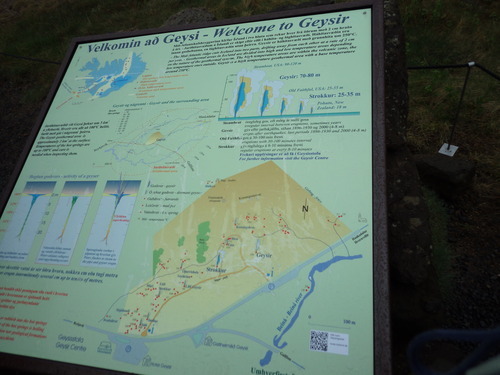
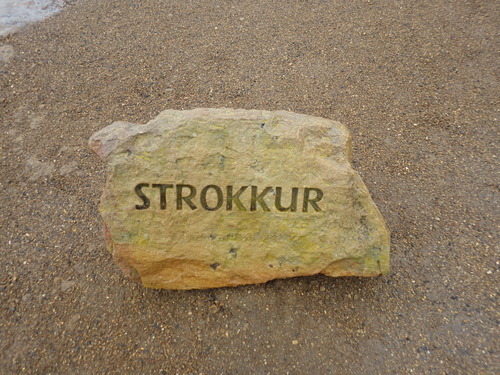
Strokkur frames.
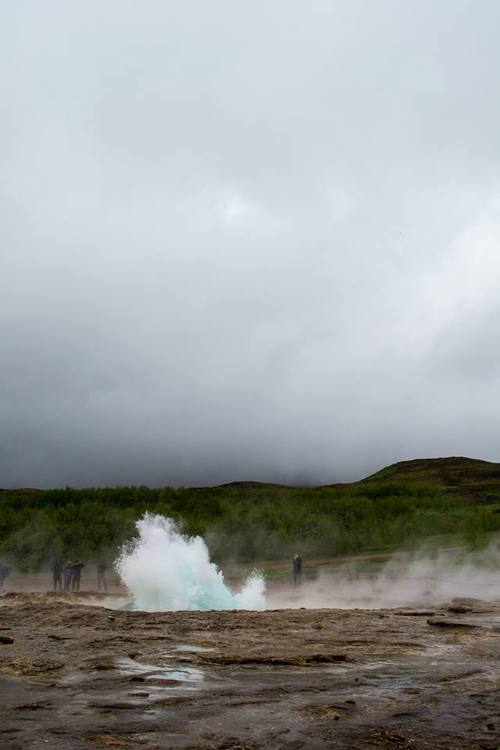
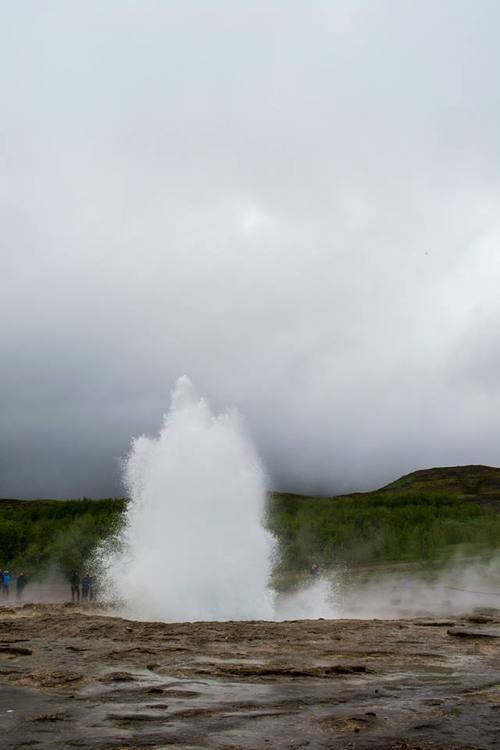

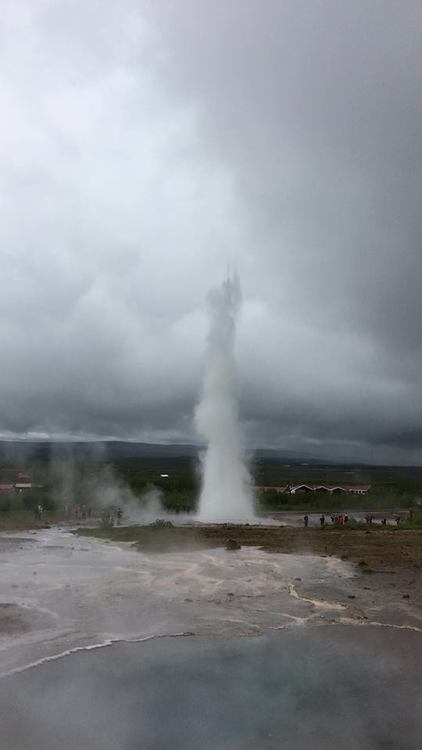
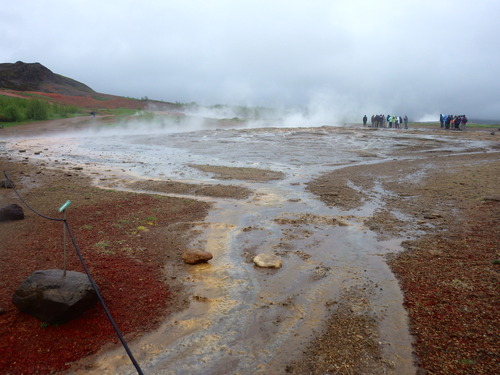
(above) Strokkur at large. (below) Colloidal effects.
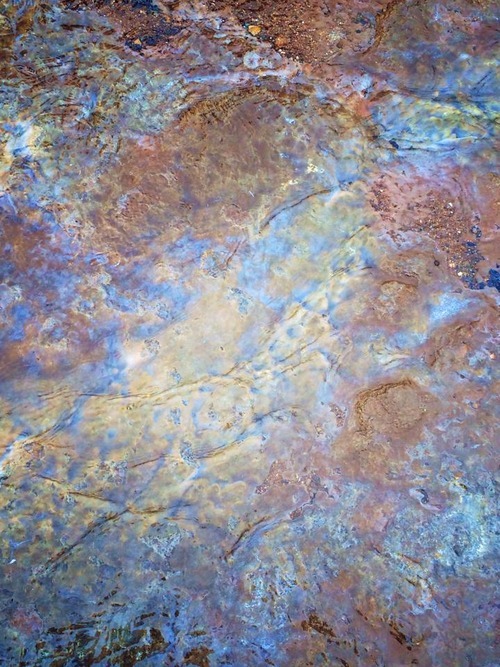
My wanderings around the area.
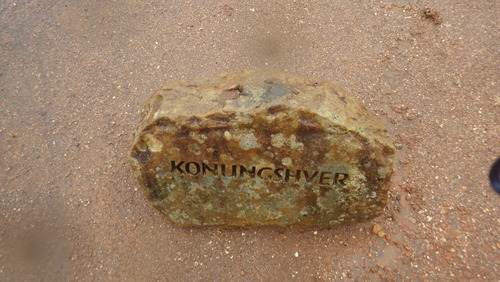
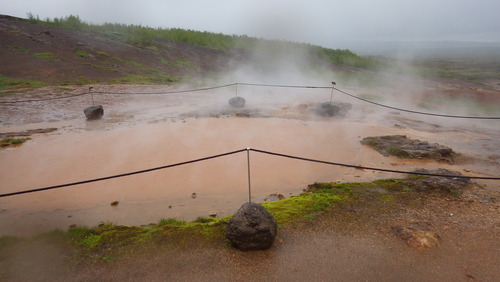
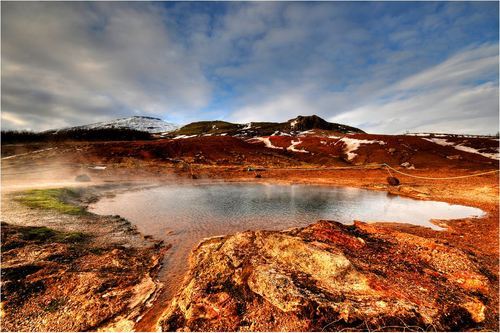
(1) Translates to "The King's Hot Spring". (2) The rain made it look much less impressive. (3) This is what it usually looks like.
Saw Mt. Laugafell; didn't know we were allowed to climb it.
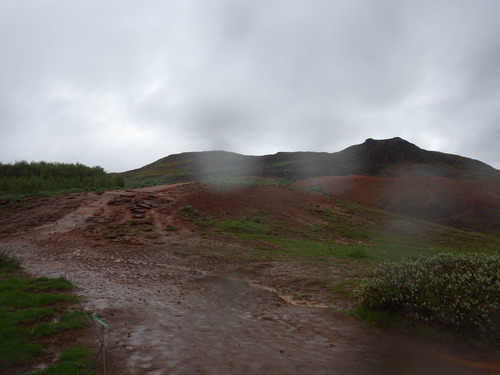
Unnamed.
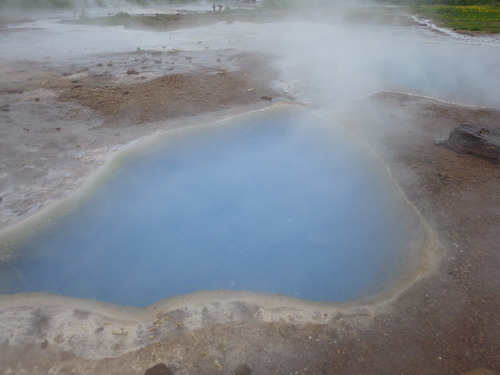

Surroundings.
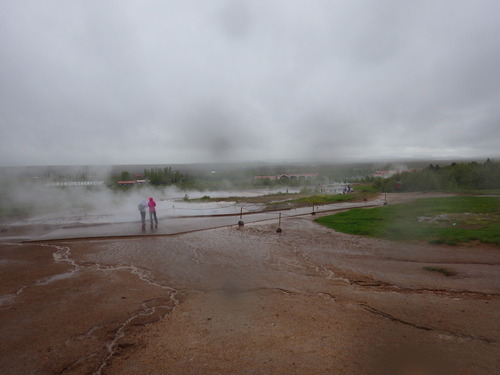

Nervously walking back to the bus, not knowing I wasn't late.
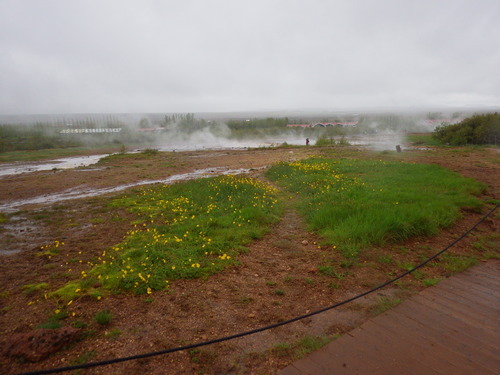
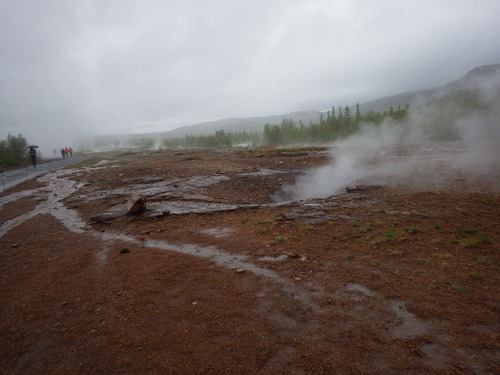
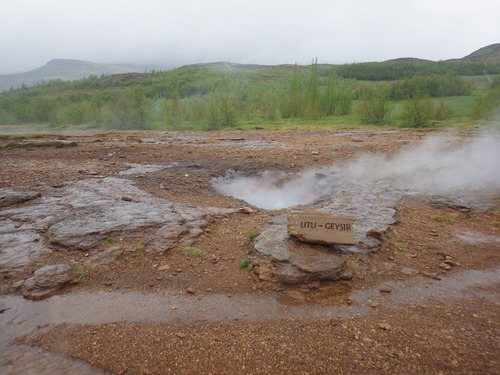
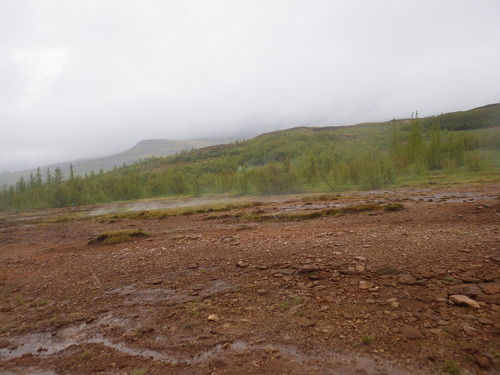

By the way, I don't remember if I already said this, but our bus was a charter bus. However, the company isn't readily identifiable because our bus had the decal "Free As a Bird". Very fitting for the GREEN Program. You'll see it later!
Everyone elses' wanderings (after seeing Strokkur and quickly glancing at the places I went to)
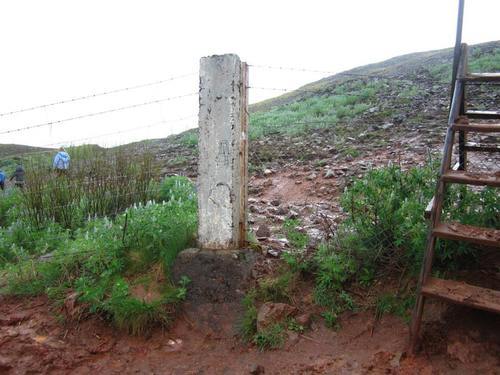
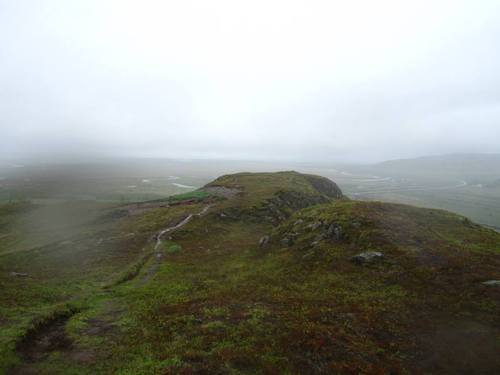
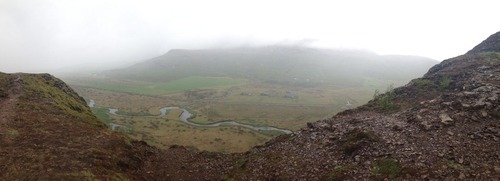
Our next stop was the legendary Gullfoss (translates to "Golden Falls").
It got its name from its golden appearance that occurs when sunlight reflects off of sediment particles in the water. There's sediment in the water mainly because the Hvítá river, which feeds the falls, contains large amounts of glacial water from Lángjökull. This glacial water is very sediment-rich if it isn't filtered by elements like porous volcanic rock. In the early 1900's, the authorities wanted to capitalize on the river's potential for generating electricity by building a dam. However, they did not have the funds necessary to follow up on this and the dam was never constructed.
For starters, mostly everyone went to the falls' lookout.

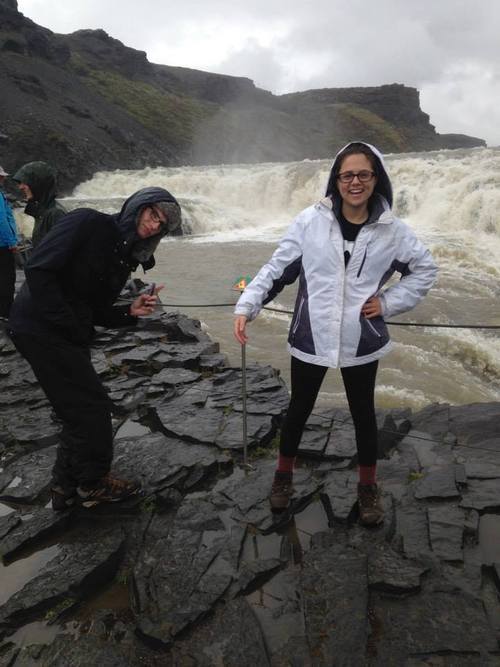
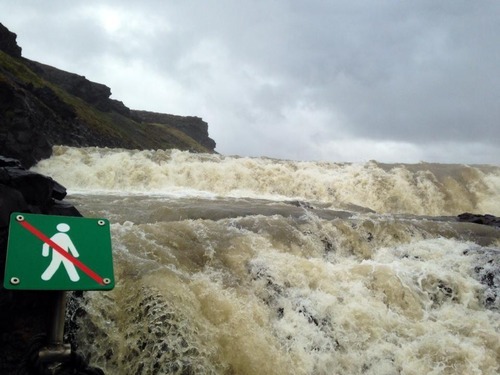
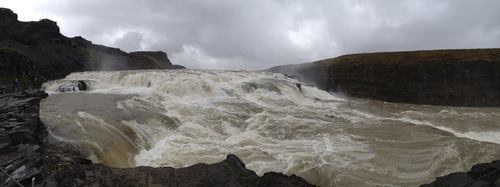
And then there was me (and probably a few others I don't remember seeing) who went up a fairly large stairwell before approaching the falls (and then went to see them up close).
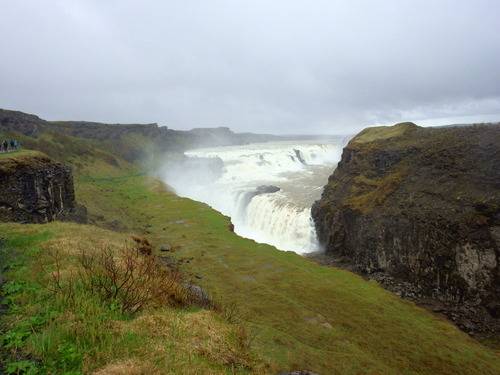
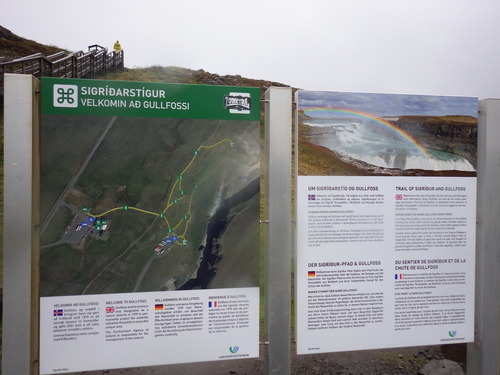
Before the ascent. (1) Obviously, the Golden Falls weren't too golden that day (cloudy). (2) Part of the stairs to the upper level behind the info board.
The views from above.
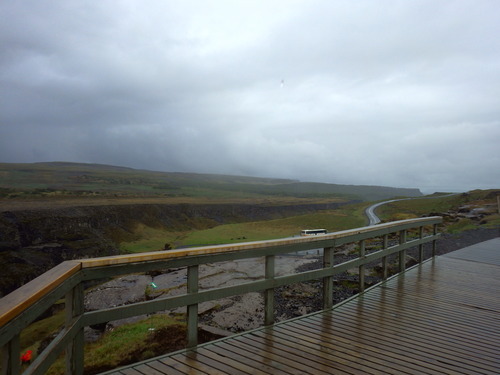

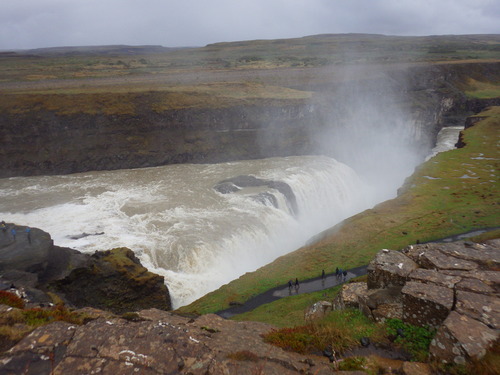
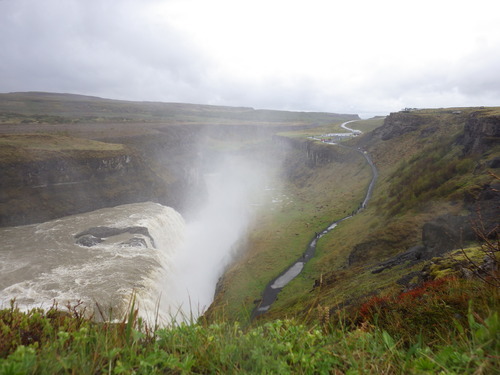




Up here I was messing with some video settings on the camera like slow-mo captures, timelapses, framerate, etc. I had it on a small tripod, and while I was messing with it I saw Mumi, Adam, and Conor. They asked out of curiosity what I was doing, and I told them just that (with the settings and all that). Afterwards, I went down to the falls, and everyone else went up.
Gullfoss was probably my favorite waterfall. You might understand why once I figure out how to post videos here.
Falls-level.
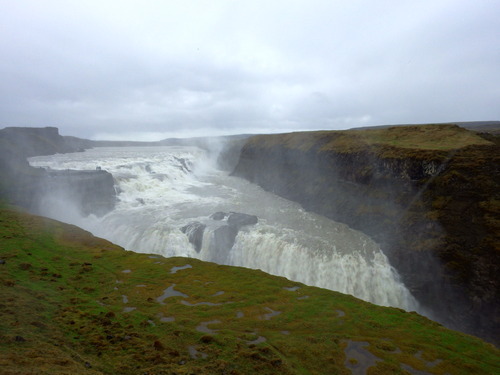
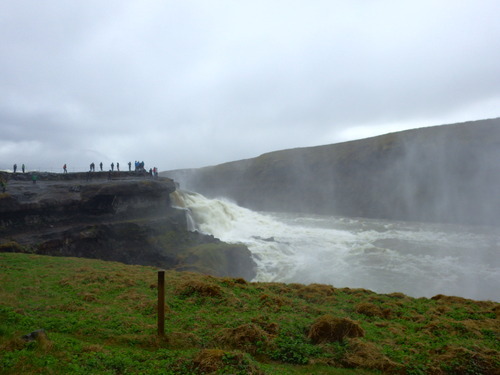
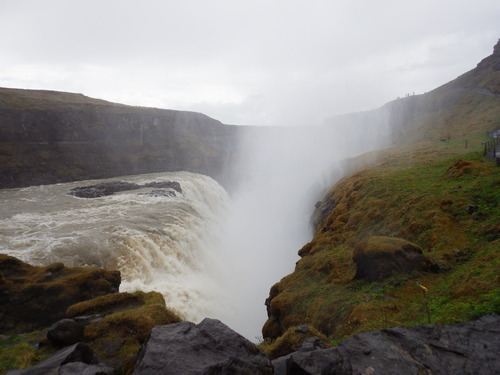
Tried pulling the tourist selfie, ended up looking like I was about to sneeze.
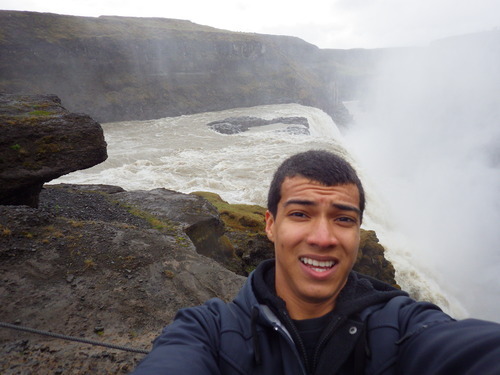
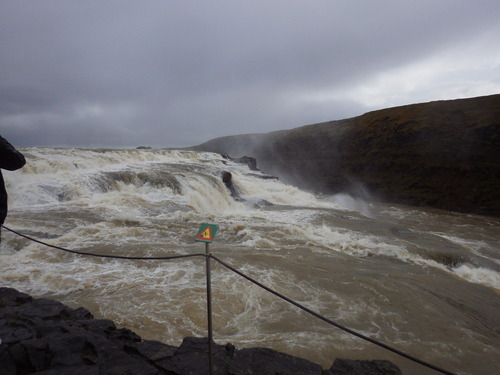

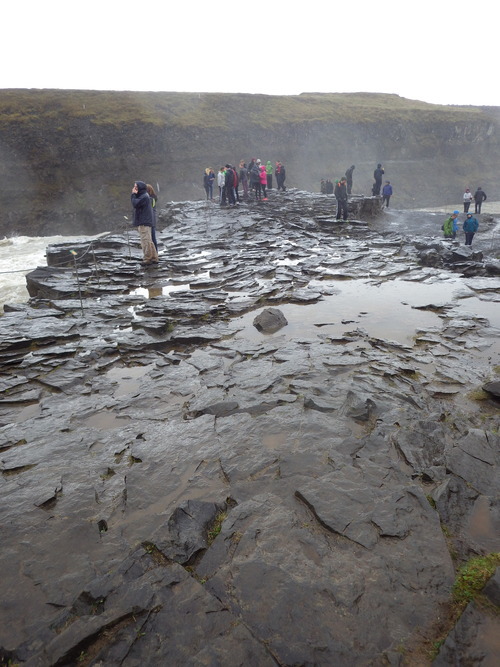
And then here, at this moment, I realized I had been out of time for 5 minutes (on this day, the leaders gave us specific times to meet back at the bus to move on to the next location). And then I ran. I ran from here to the stairs, took a break, tried running up the stairs, ended up walking half of it, jogging half of it, and then running all the way to the bus. I was out of breath for the next half hour and would be referred to as "that guy" by my colleagues for the rest of the day.
#GREENprogCH1#thegreenprogram#iceland#summer#the tourist traps#golden circle#geysir#gullfoss#adventure#breathless in too many ways#waterfalls#geothermal field#being that guy#minor struggs#now its time to get educated
1 note
·
View note
Photo
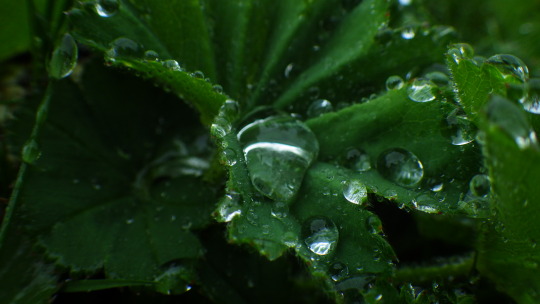
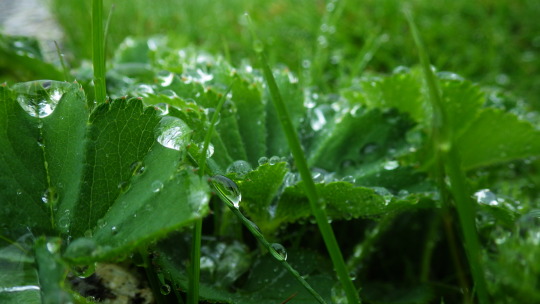

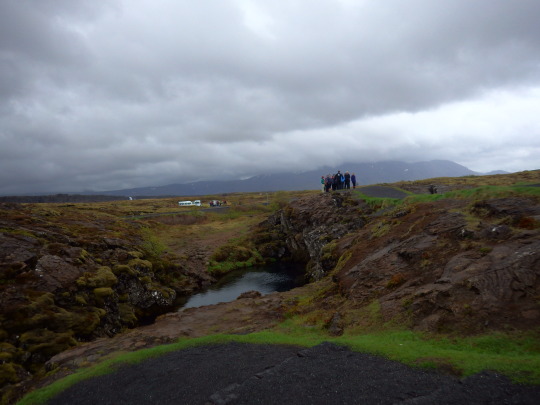
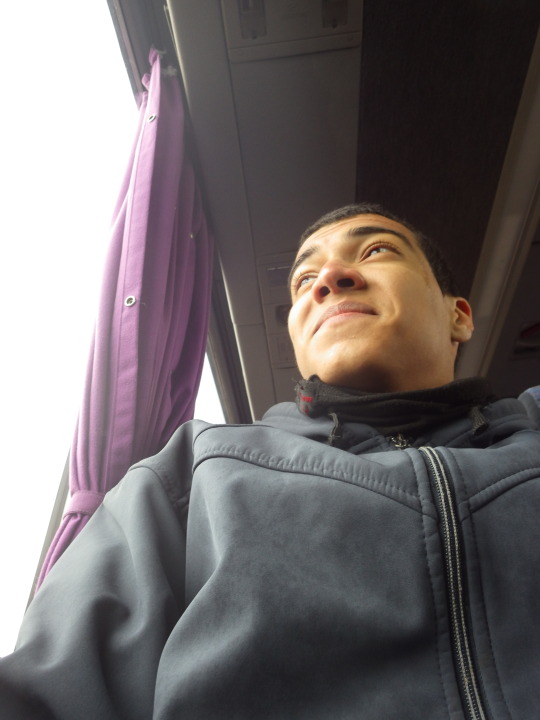
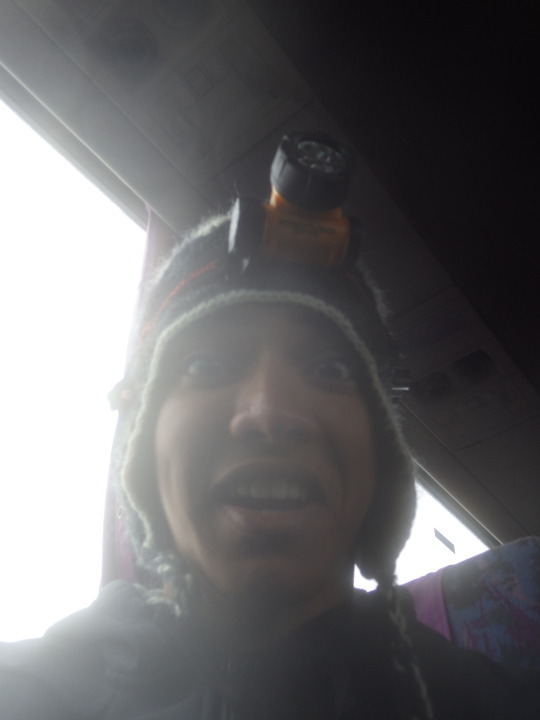
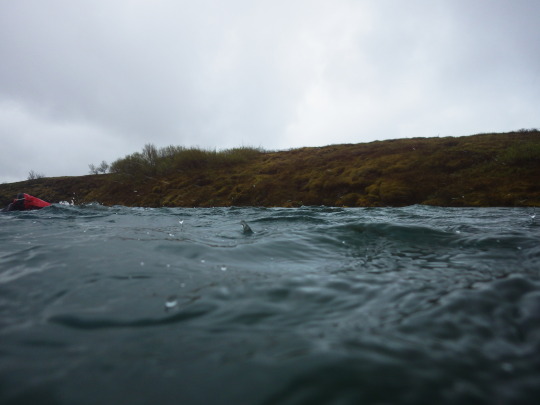
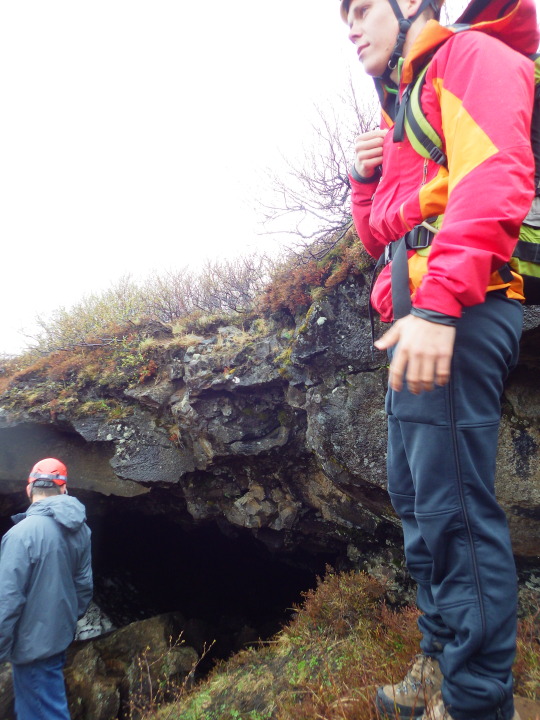
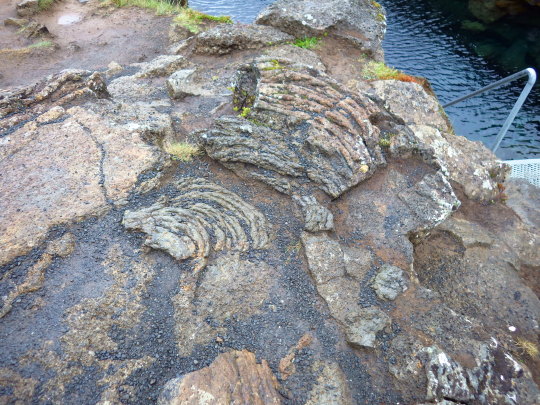

Leftovers from Day 4.
(part two)
#GREENprogCH1#thegreenprogram#onlyonthegreenprogram#iceland#Silfra#Þingvellir#Gjábakkahellir#national parks#macros#snorkeling#spelunking#adventure#summer
0 notes
Photo
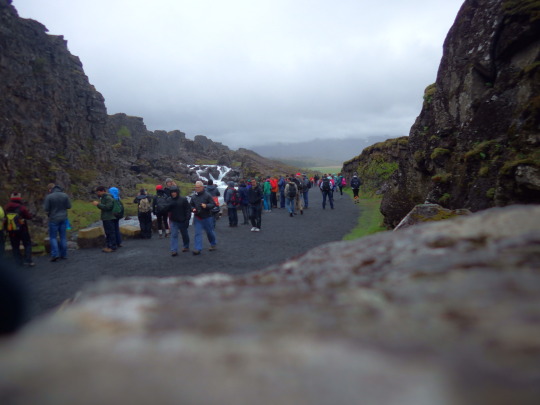

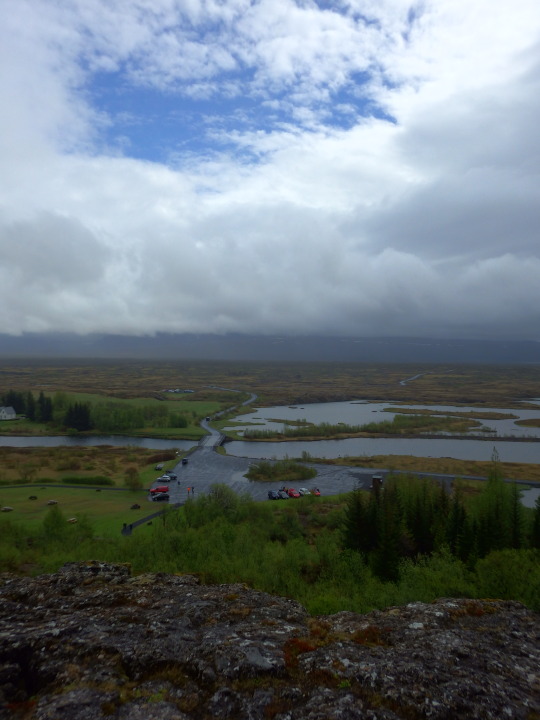

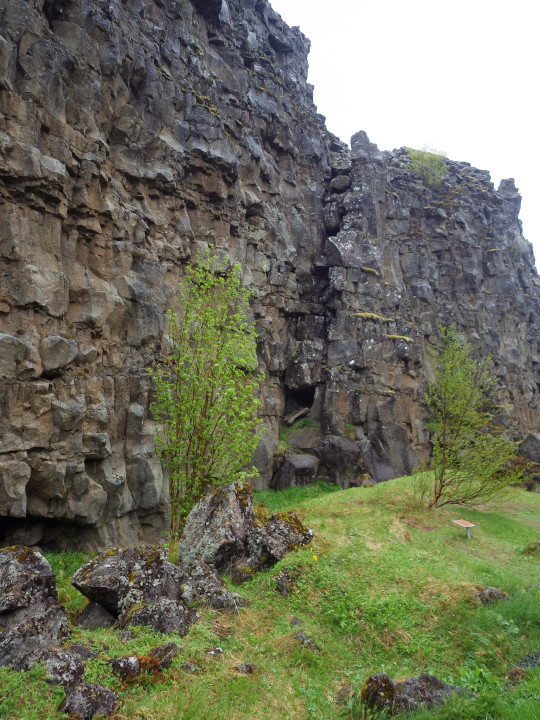
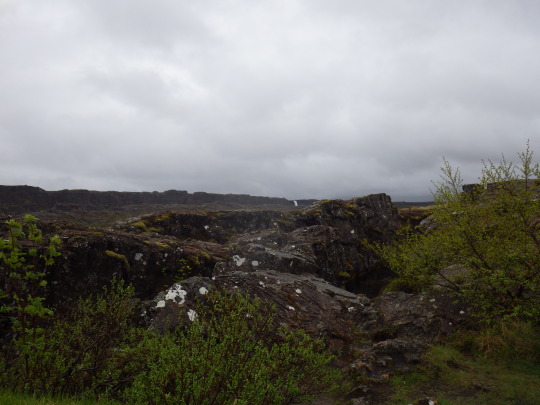
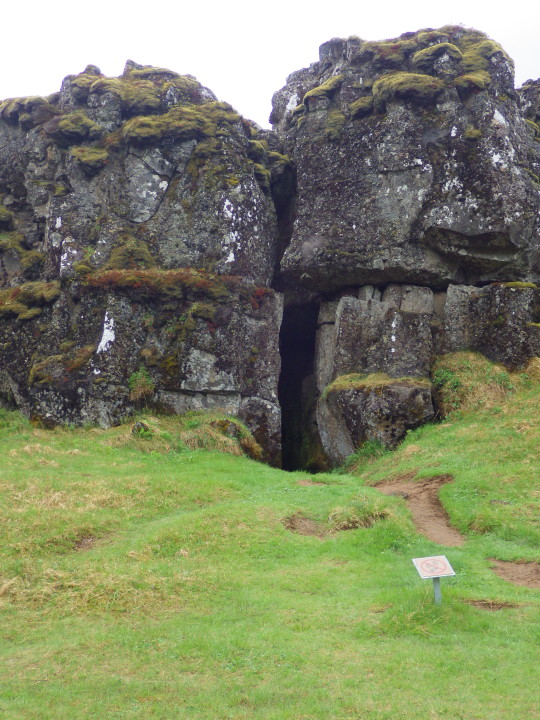
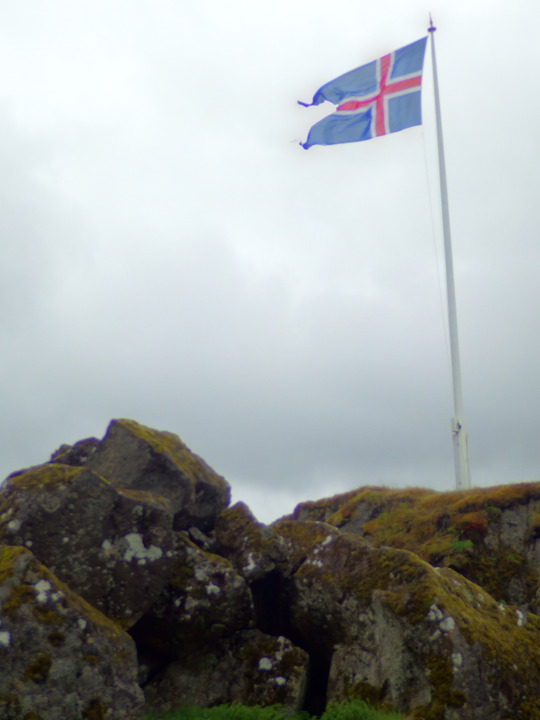
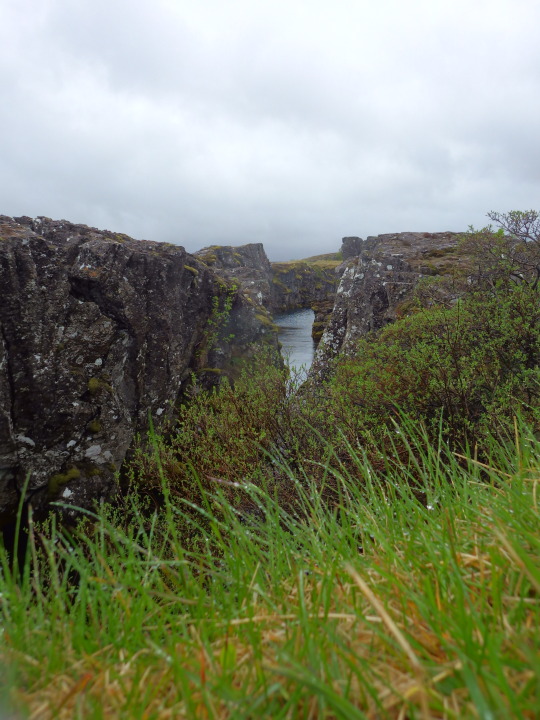
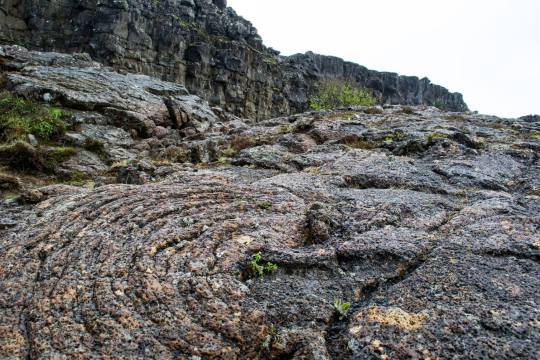
Leftovers from Day 4.
(part one)
#thegreenprogram#GREENprogCH1#onlyonthegreenprogram#Þingvellir#Silfra#geology#formations#Iceland#artsy#blue#clouds#day 4#pictures#extra
0 notes
Text
Þingvellir: Going Home (Hjarðarból)

Þingvallavatn and all of its gorgeous turquoise from my window.
The ride to Hjarðarból was relatively quiet because most people were sleeping. I stayed up because I'm a sucker for landscapes.
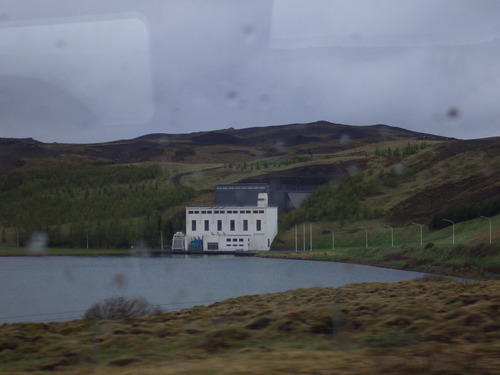
A hydropower dam that uses Þingvallavatn's sheer volume as the driving force for power production.

Lots of horses.

I'm a sucker for what I'd call "cloudscapes" too.

Close enough to "touch the sky" without going higher than 200 meters.
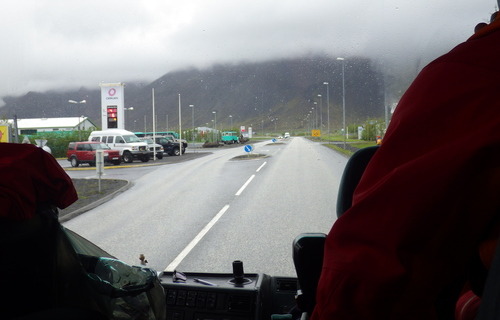
Driving through Selfoss (the town right before Hjarðarból).
Finally home....
I remember getting to Hjarðarból and wanting to go to sleep. But that didn't happen because it was around 6 PM (18:00) at the time we got back and there was still dinner to be had and a capstone to be started. I don't remember dinner, but I do remember the beginning of capstones: as if it was yesterday. Because I spent the first half hour trying to find a group.
When it comes to self-assembled groups for projects, I'm the kind of person that waits until someone picks him. No one picked me until half an hour after it all began, and they picked me only because I made it clear that I was one of the stragglers. But boy, was I glad I was part of that group. We were a group of 6: Hannah, an environmental studies/political science double major from George Washington University; Clare, an environmental engineering major from Cornell University; Rachel, another environmental engineering major, this time from Purdue University; Kevin, an electrical engineering major from McMaster University; Jahred, an environmental science/engineering major from Harvard; and me (chemical engineering, Carnegie Mellon University).
We did about half an hour of brainstorming before settling on a central theme to the capstone: green roofing.

A green roof in Chicago. Helps with cooling the building, combating the urban heat island effect, and improving runoff.
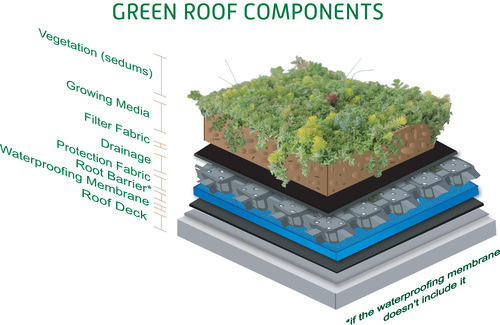
I say a central theme because it wasn't exactly what the project was going to be about. A bit after that, Adam and Conor reached our group (they were coming around to all the groups). The baseline expectation for the capstone as a whole was to develop a sustainability- or renewable energy-based idea that would be possibly marketable in the future. We initially had trouble explaining all of our thoughts to them since they weren't entirely coherent and needed further developing. Nevertheless, the leaders were glad we had reached some kind of consensus and encouraged us to pursue it further. And for another hour, we did. And by the end of the night, we had our capstone idea. It was based on a scenario where the state of California conveniently proposed legislation that promoted green roofing by incentivizing the use of green roofs and offering bonuses to businesses that took an active role in offsetting carbon emissions. Our goal was to (under the guise of one "Urban Canopy", a green consulting firm) analyze the effect that large-scale green roofing in Los Angeles would have on the city's carbon footprint.
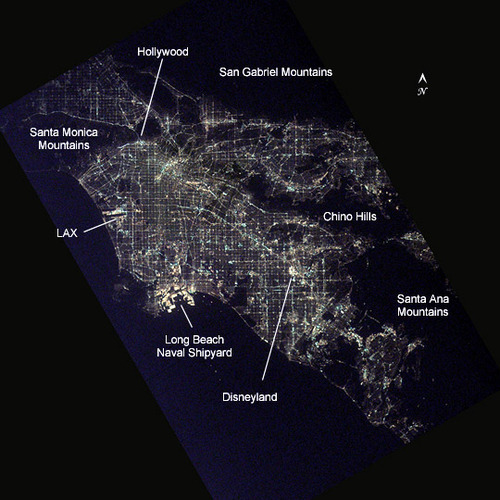
Los Angeles, the United States' second largest city, from space.
After reaching that solid idea, we split and called it a day. Before sleeping, I decided I'd pack my bags in the morning. And then once again, dropped like a stone.
I'm pretty sure I relived that day in my dreams too.
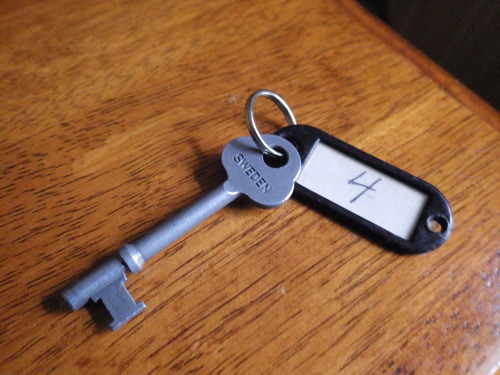
The key to my room. I'd never seen a key like this before and thought it was kind of cool.
#GREENprogCH1#thegreenprogram#iceland#summer#landscapes#education#study abroad#travel#capstone#projects#green roofing#policy#engineering#science#mostly text#day 4
0 notes
Text
Þingvellir: Silfra (Part 3)
So, after an absolutely lovely packed lunch (consisting of that sandwich I mentioned earlier plus a large yellow apple and a juicebox I did not mention), it was time for a pretty cool day to blow every other day I've lived out of the water.
Beware of.... crossing divers?

Got off the bus, saw the Puffins and Unicorns ecstatic after their snorkel run, met the Scuba Iceland team, and began the suit-up process. For starters, we had to remove extra layers, our boots, and our socks so we could comfortably fit in the suits; I was late to the game because I was taking it all in for a while.... we were provided with wool socks that I put over my normal socks (bad idea; lead to a very tight fit with the dry suit and the flippers, but I got over it quickly).
When I saw Adam (bearded guy, one Program Leader) help (insert-she-who-I-cannot-identify-by-her-hair's name here) into her suit, I knew this "suiting up" thing was no joke.
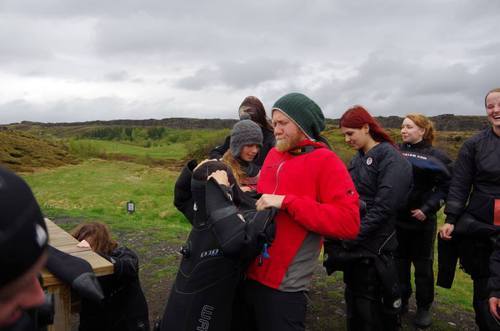
I needed a ton of help myself, but overall, it was pretty fun.
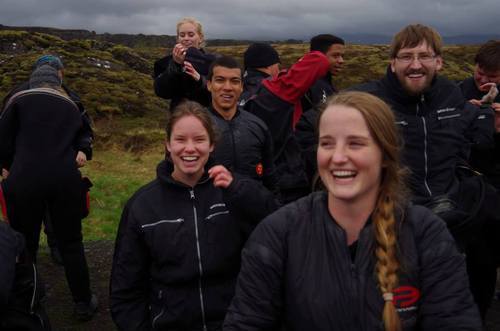

The Swanson.
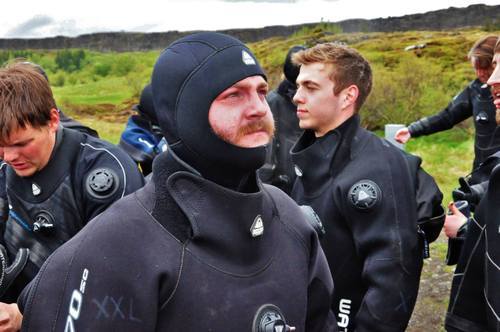
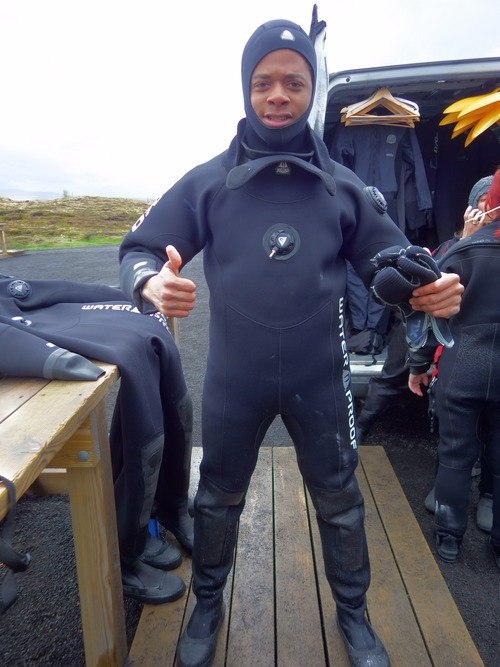
The suit consists of: an inner insulation layer, an outer waterproof layer (drysuit) with air pockets (for buoyancy), the insulating hood, somewhat-waterproof and somewhat-insulating gloves. And of course, the snorkeling equipment.
Just the GREEN team.

And with the Scuba Iceland team.
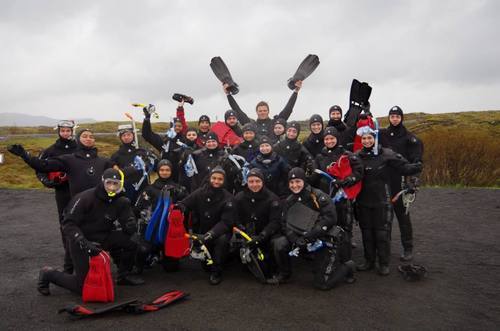
The first team in and a small bit of the fissure from above.
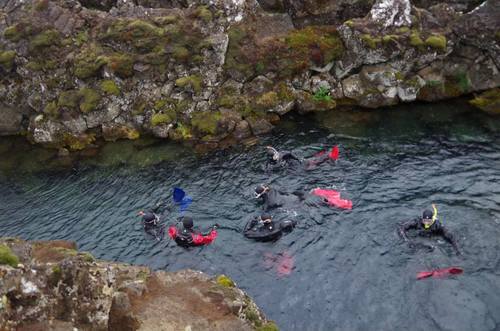

I look back and I have no idea why I took a picture of the flippers. However, I do know it was while I was in line, waiting to go into the Silfra.
Back of the line, still incredibly excited.
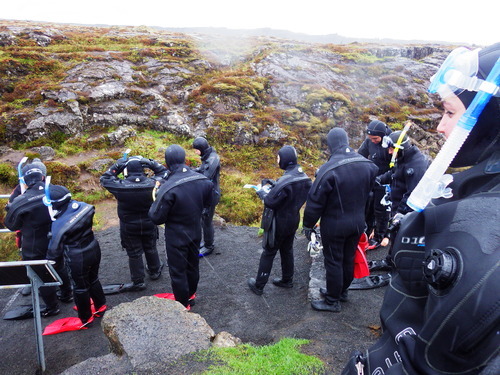
Courtney and Julia, two fellow Dragons that would be in my group for the excursion. Oh, and our leader (whose name I do not recall, but more on her later anyway).
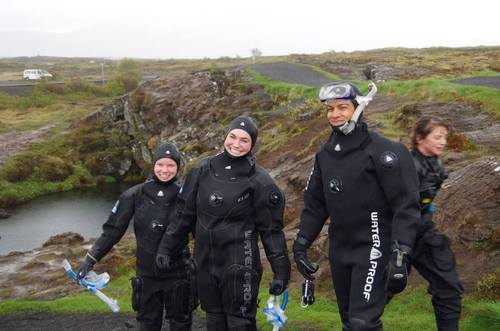
Pre-tectonic-plate-snorkel selfies? I got that.

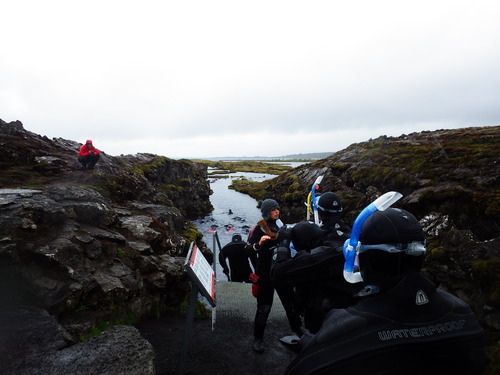
Moments prior to the plunge.
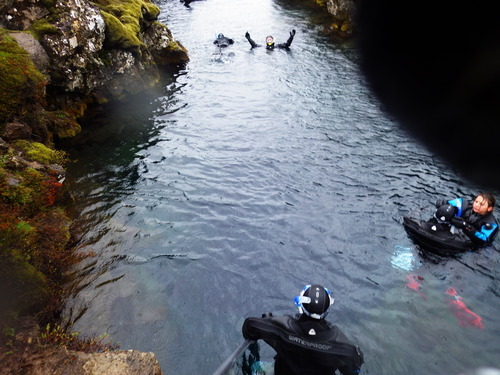
First sight. First thought: "Where was this when I looked in from above the water???" (Pinch-me-I'm-dreaming moment #4)
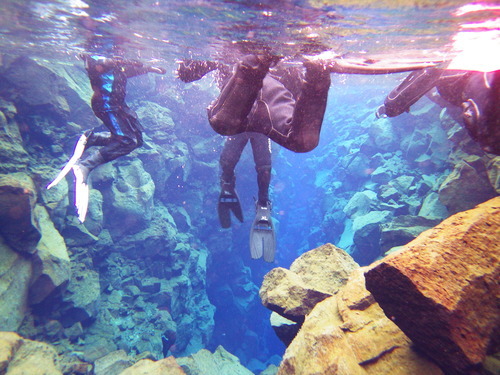
In just a little further.
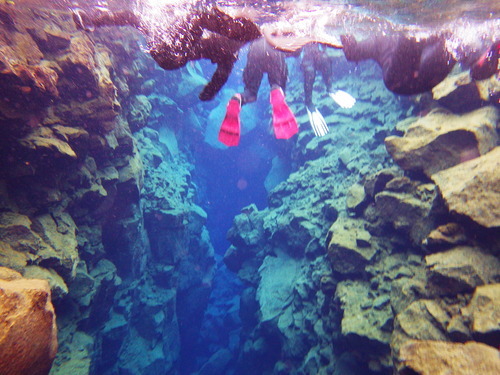
So now that you have a just a smattering of what I saw, let me explain what I was feeling. Honestly, everything happens so quickly that you don't even notice until it's too late: it took all but 20 seconds for the parts of my face that weren't covered by goggles or snorkel or hood to go completely numb. So cold wasn't an issue. Now, the water seeping into my gloves was a little annoying, but it was nothing that hindered the experience. After all, (in the dive team's own words): "cold is just a state of mind."
Now, enough words. Just pictures for awhile.


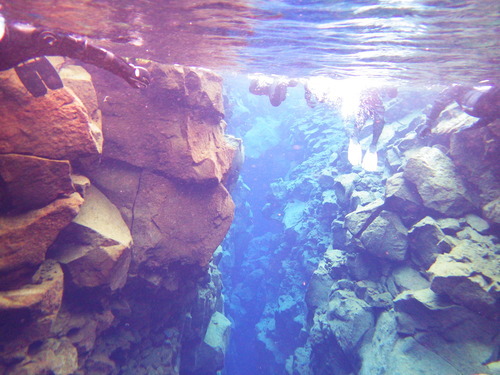



A bit of a break. And some frustration.

So I had never been snorkeling before, and had zero luck getting the technique for the flippers down. I also had my camera in one of my hands, so I used one arm to take me from the beginning to here, which is a small lagoon thing about a third of the way through the route we were following. I was kinda pooped here and I was very far behind my group. At this point, the leader came back to get me, and I felt like the team's biggest loser. And by that, I really mean I felt bad for being so slow. This trend would repeat several times throughout the snorkel.
Aaaaand we're back. Those plants were the only life we got to see in the fissure. Now, that doesn't mean that's all the life there is in the water (more on this a little later).
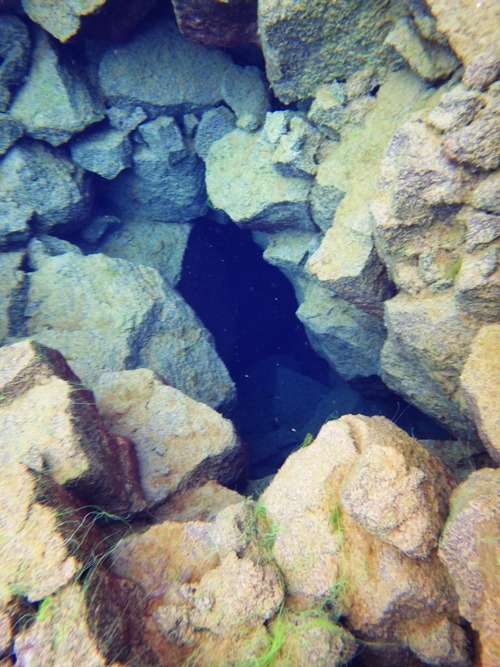
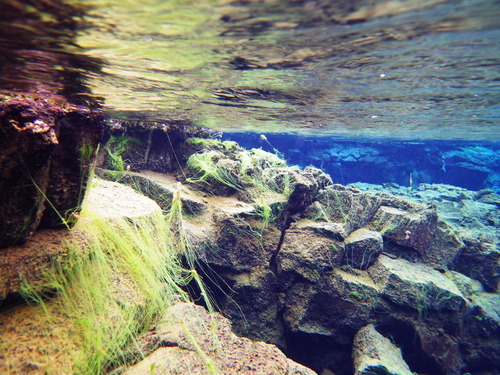
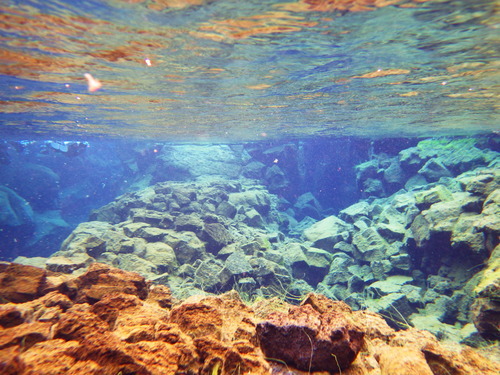

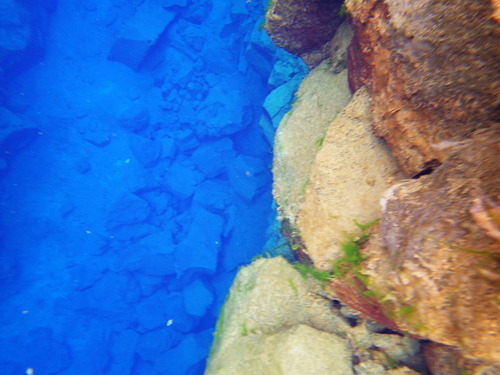
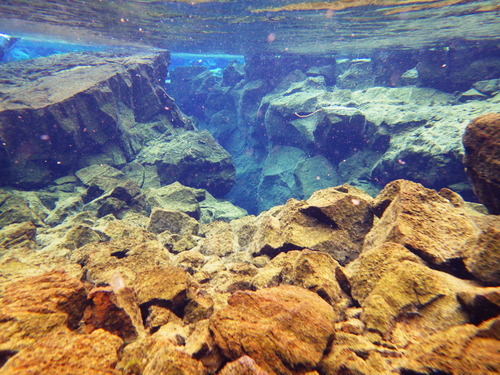
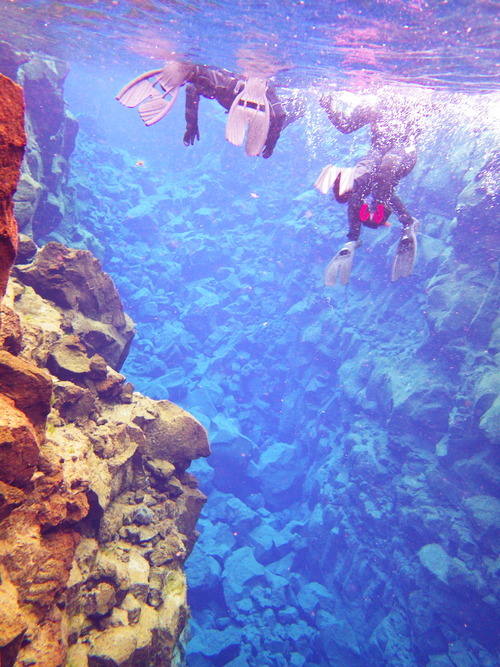
Pinch-me-I'm-dreaming moment #5: The Silfra Cathedral (a picture from the surface couldn't do it justice...)
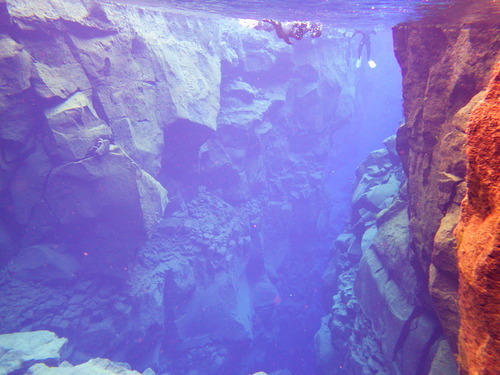
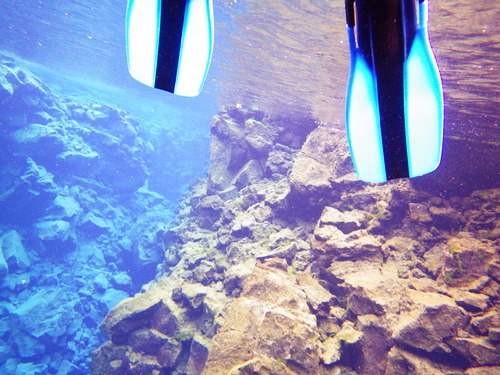



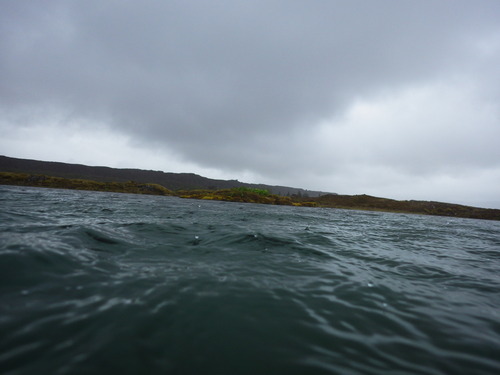
The end.
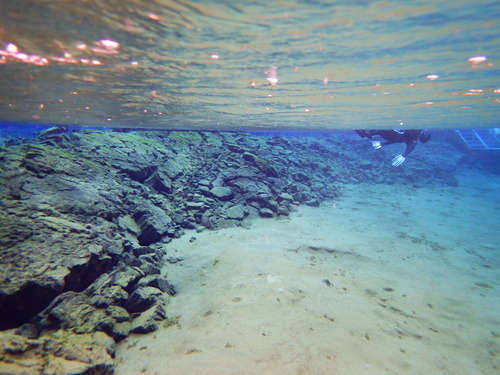
Of the snorkel, anyway.
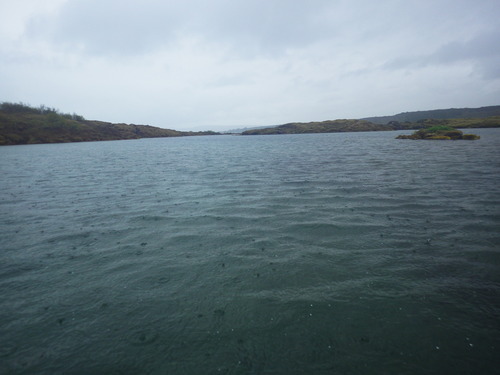
Between the end platform and the jump, I apologized to my leader a bunch and asked her about where she was from. If I remember correctly, she told me she was from France, and was relatively new to this dive site in Þingvellir (she had been working here for some time, but not too long). She had a pretty heavy accent so conversation was a little difficult. One of the first questions she asked me was if I had tried the water; at that point, I hadn't and was a bit sad. However, I would get another chance.... after jumping off of a cliff.
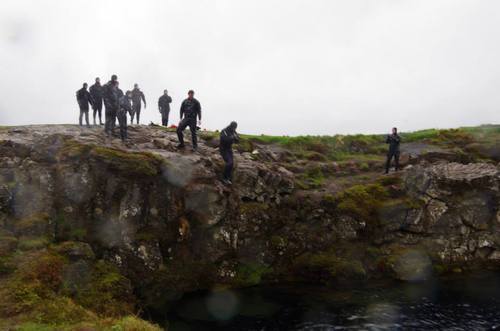
Okay, "cliff" is a hyperbole. Maybe "relatively large ledge" is slightly more accurate.

I was last to go. And of course I tried something kinda different.
Karate kid or nah?
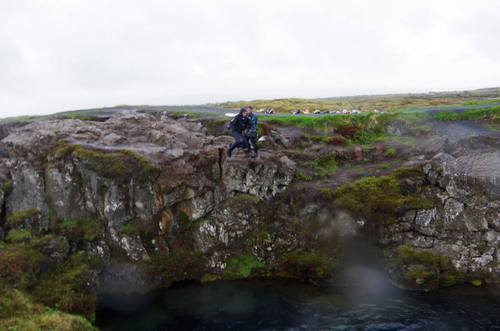
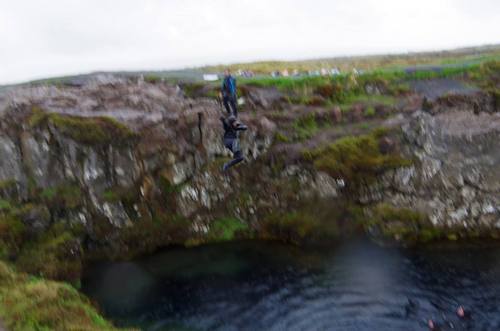
Between the picture above and the next picture: the plunge was a bit of a shock after regaining feeling in my face from the snorkel. I opened my eyes under the water and the cold licked my eyeballs until I got to the surface. Even if it hurt a little bit, I could see down there just as clearly as I could with the goggles. When I got to the surface, I almost forgot to take a drink. That moment set the bar for my drinking water, and that expectation will not be met by any other water for a long time. And by that I really mean about 4 more days.

After this, we got back into our regular clothes. I met another dive team member from Belgium who had been at the site for a pretty long time now, and he was a great help in helping me get out of the suit. From there we took another group picture with the dive team (can't find it), picked up the Puffins and the Unicorns, and headed back to Hjarðarból for dinner and capstone work.
Next time I go to the Silfra fissure, I will have my scuba license.
P.S.: This excursion wowed me that much because I had never ever gone snorkeling before. But now, even after snorkeling at multiple locations in the Caribbean, I still loved what I saw in Iceland because it was such a departure from typical snorkeling locations. Oh, and I've pretty much mastered flipper technique.
#GREENprogCH1#onlyonthegreenprogram#snorkeling#Silfra#Þingvellir#glacial#water#blue#green#adventure#travel#study abroad#we arctic now#dreaming or nah?#day 4#favorites#iceland
0 notes
Text
Þingvellir: Gjábakkahellir (Part 2)
After a short ride around the edge of Þingvallavatn, we reached the cave. I got really excited putting on my headlamp, and I was even more excited when I got the helmet to go with it.
Þingvallavatn in the distance.
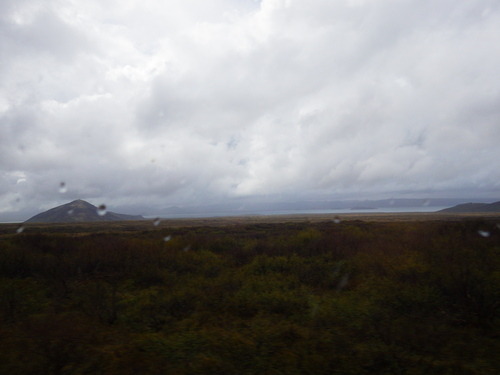
The cave, Gjábakkahellir, was a lava channel. It was discovered by workers in 1907 when the King of Denmark had a road constructed between Þingvellir and Geysir. Lava channels like Gjábakkahellir form when the top layer of flowing lava cools into a crust while conduits of deeper, less viscous lava continues flowing. When the upper layer completely cools, the lava in the conduits drains out and leaves these tubes.

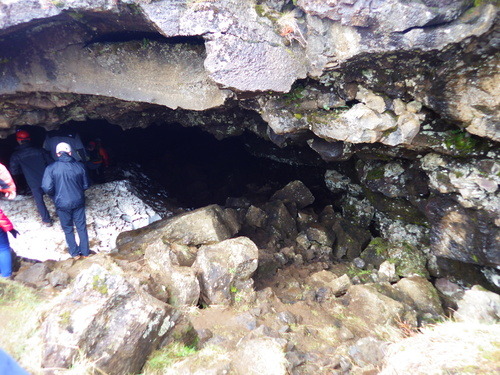
First steps, lights on, and there's snow?

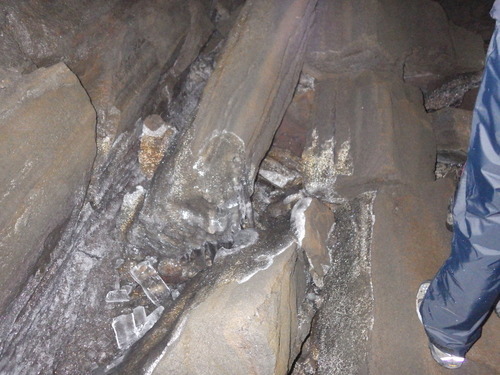

Around the corner.


At this point, Mumi had us all sit down and explained a couple things. First off, apparently those things on the ceiling are called "lava titties". They formed at the onset of lava drainage out of the channel: when the lava level in the channel is just below that of the ceiling, the bubbling lava tends to cling to the ceiling and then drip off, thus leaving behind these formations. Second, Gjábakkahellir, which means "Little Girl's Cave", was named after an Icelandic tale that had something to do with a family retreating into the cave for some reason, and the parents realized they'd starve down there so they spared their children a slow death by killing them.... and legend has it that if you're really quiet, you can hear whistles of the children (mostly those of the girl) in the cave. I know, really grim tale, but that's the story. And of course, after telling a scary story, you need darkness. So Mumi had everyone in the cave turn off their headlamps and remain silent. I had never seen such a perfect darkness; the silence wasn't perfect (because of the echoes of dripping water throughout the cave) but it was close enough. And of course someone had to end it by trying to whistle. It was good while it lasted.
Continuing on.
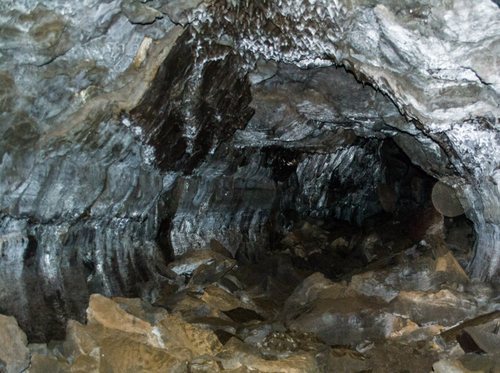
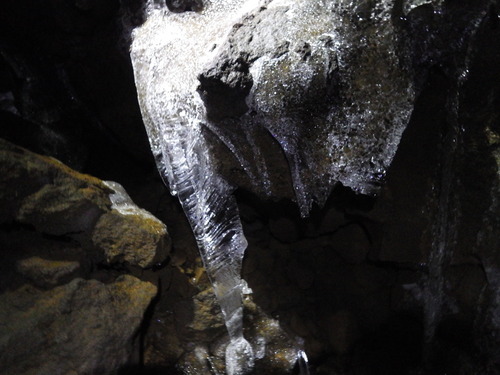
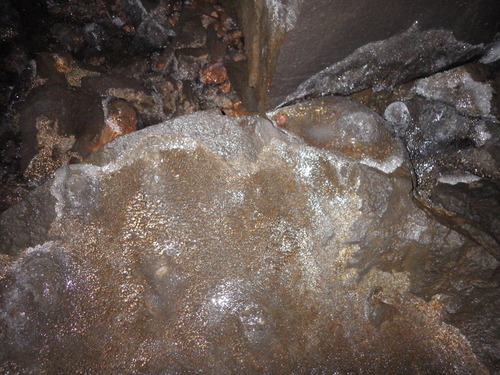
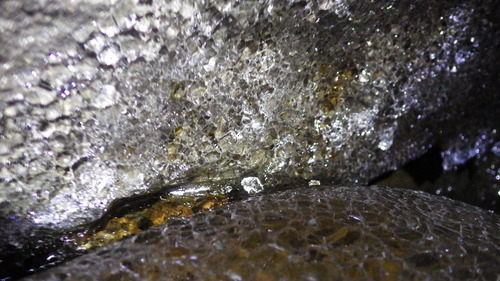

This cave was pretty slippery at times because water leeching in from the cave's openings froze wherever it had a chance to settle within the cave. I also bumped my head quite a few times on some tight squeezes that we had to maneuver through. I don't think I knew how to really appreciate helmets until then.
The light at the end of the channel.
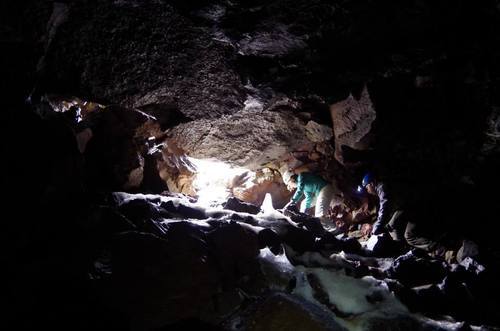
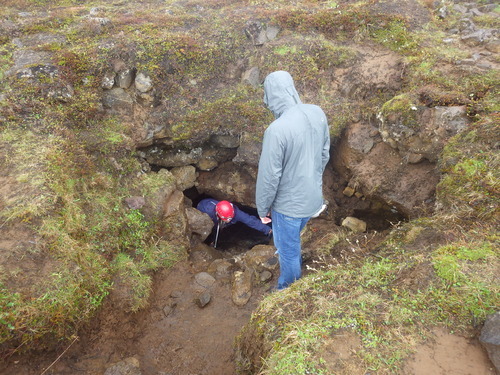
As it turns out, the channel is a loop!

Group picture time.
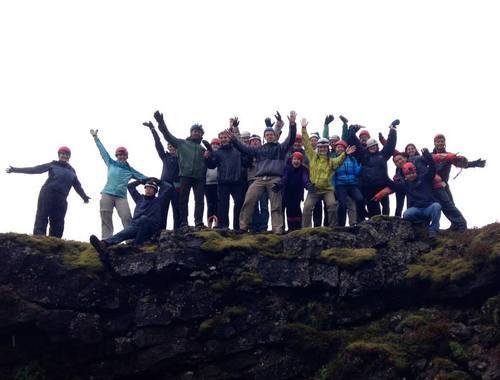
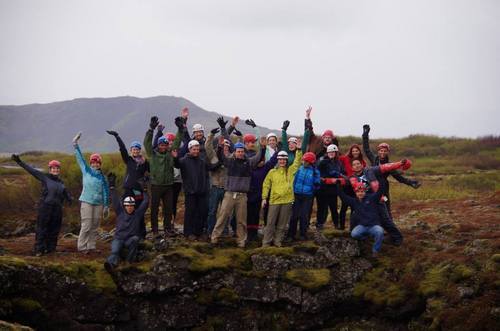
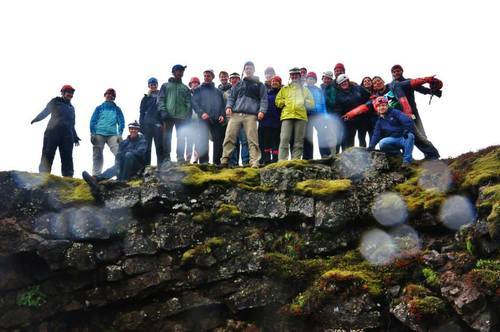
After taking off my gear and eating lunch on the bus, we departed for Silfra.
#GREENprogCH1#day 4#onlyonthegreenprogram#the green program#gjábakkahellir#spelunking#caving#iceland#adventure#folktales#geology#travel#study abroad
0 notes
Text
Þingvellir: National Park (Part 1)
Day 4. Our last day staying at Hjarðarból. We were told to pack lunches from what was available at breakfast; I had zero qualms about this and immediately made myself a pretty good sized sandwich containing a pepper spread that the guesthouse owner made for us. She made pretty much everything that required preparation from scratch, and the effort was reflected in how good everything was. ESPECIALLY THOSE SPREADS. My goodness. I had some every morning.....anyways, back to the story.
Arriving at Þingvellir National Park, we got our first great look at what a tectonic plate boundary actually looks like.
Standing on the North American Plate, looking at the Eurasian plate.

Just beyond the edge of the viewing area, you can see the rift that opens due to the separation of the plates. Now, entire tectonic masses separating doesn't make a clean cut. There's many, many secondary cracks that open up as a result.
Like these.
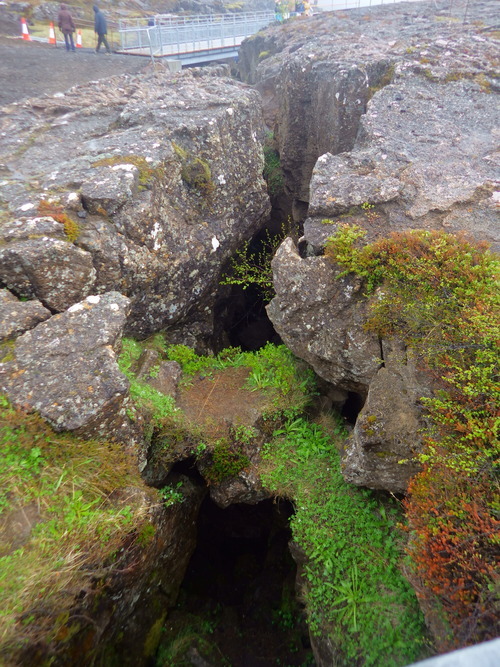

Here's another look at the rift.
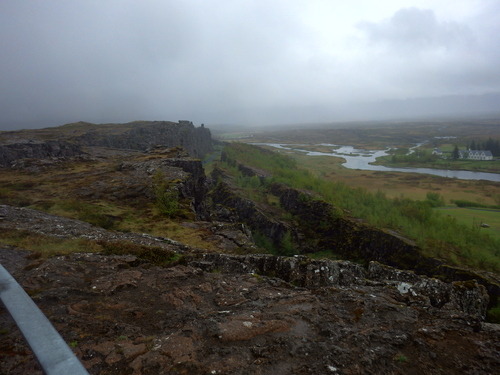
Overall, we only got to see a small portion of the park, but even what we saw was more than enough to blow minds. For this first portion of the day, we walked around the park.
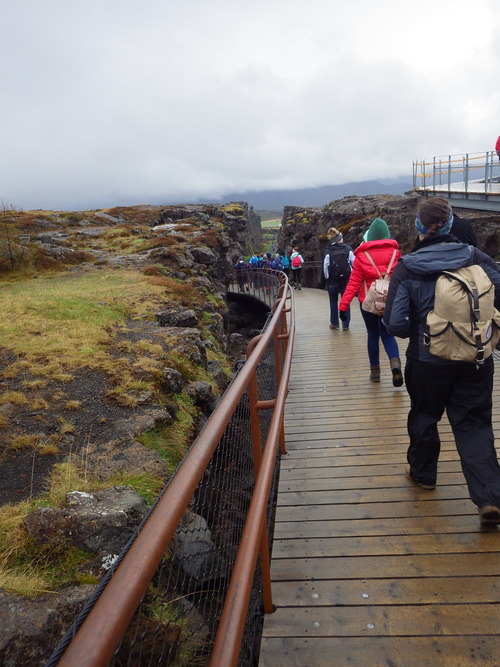


Walking in the rift.

A small waterfall in the rift.
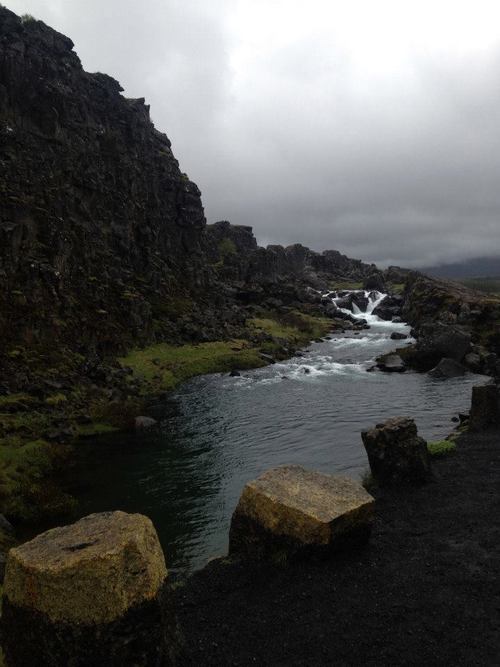
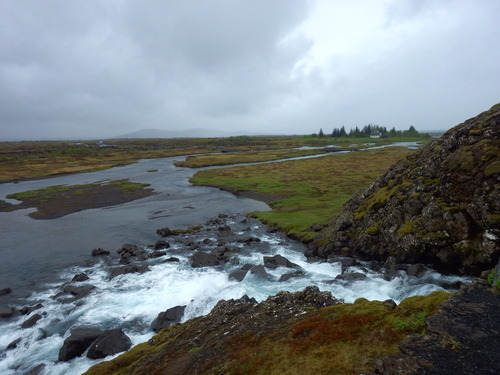
We made our way around the rift and started walking towards the Silfra, which is a fissure containing some of the clearest water you can dive in on the planet. That water makes up the Silfra River, and it flows in Þingvallavatn, which is Iceland's largest lake. All of the water that flows into Þingvallavatn from one way or another originates from Lángjökull, which is Iceland's second largest glacier.
Silfra fissure.

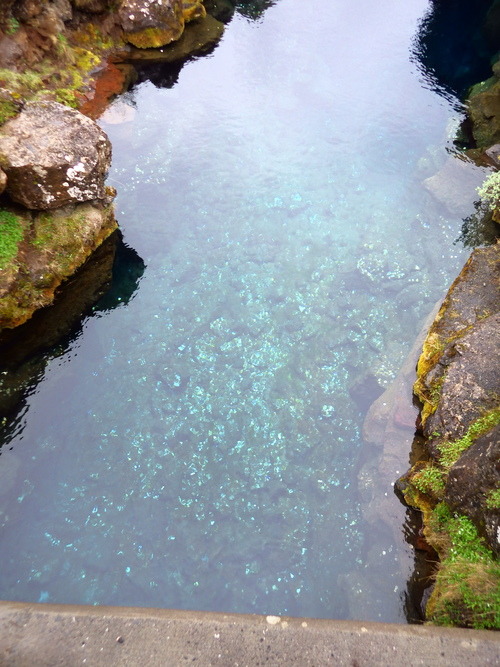
If you look really closely at the picture below, you see me kneeling by the water's edge. That was me putting my waterproof camera to its first test.
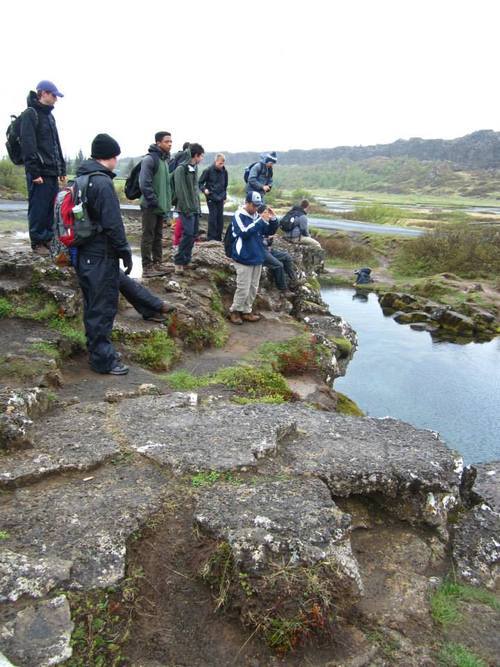
I'm pretty sure it passed. And that's good because I got my first feel of what it was going to be like to snorkel in these waters.
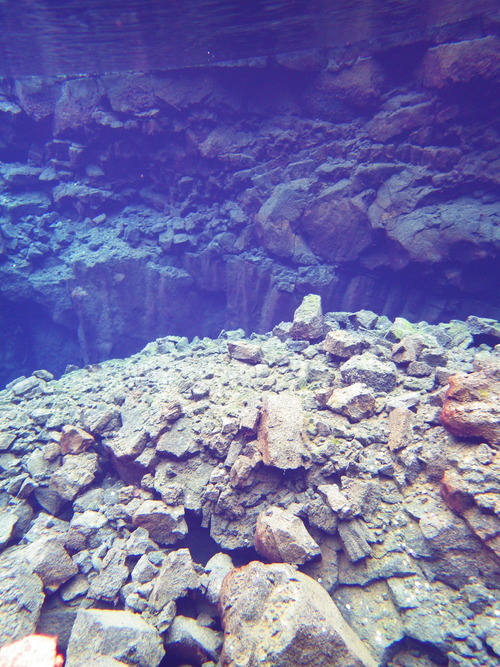
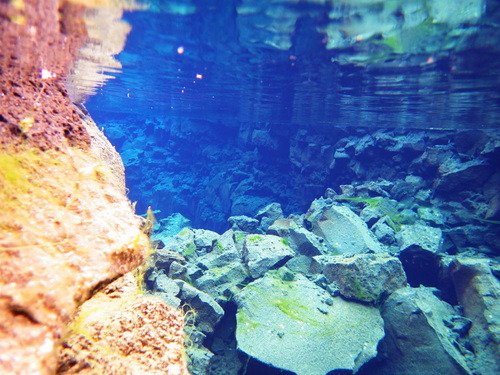

I asked one of the guides how all this water got so clear, and they told me the water that melts from the base of the glacier takes a 30 year journey to filter through the area's porous volcanic rocks and end up here. And you can bet that that water is naturally some of the cleanest in the world. Forget Poland Spring, I'm drinking straight out of Iceland!
After a group picture, we got to see a small settlement generally reserved for the park rangers.

Ranger dwellings.
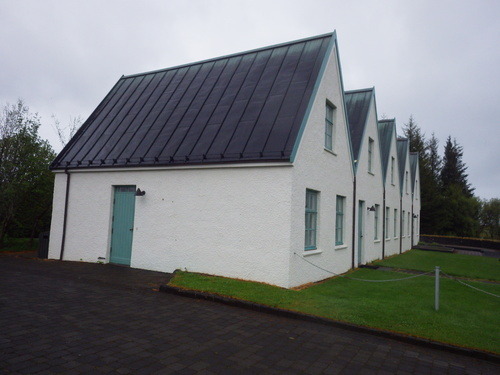
Þingvallakirkja and its cemetery.

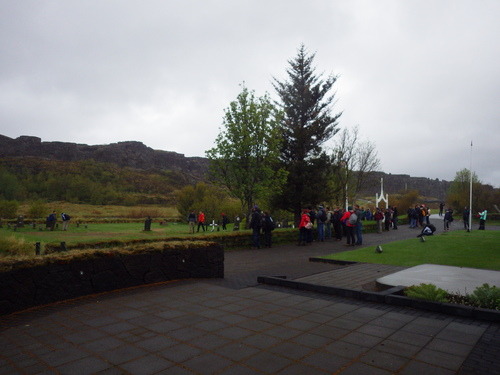
Þingvellir from behind Þingvallakirkja.
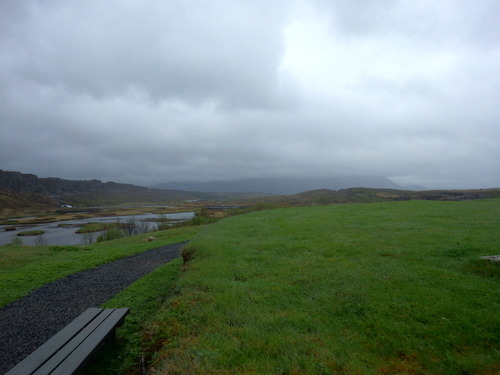
Around here, I picked up a discussion with Helga and Mumi about why Þingvellir was important. As it turns out, Þingvellir is a very significant place in Iceland's history because it was where Alþingi, Iceland's first parliament, was held. That gathering was held here between 930 and 1799, and the meeting place was the country's capital at the time. Alþingi was discontinued for 45 years after that and moved to Reykjavík when it returned in 1844. In 1930, the Icelandic government founded Þingvellir National Park as a means of preserving this site, and in 2004, it was declared a UNESCO World Heritage site (this information is a mix of what they told me and what I found on Wikipedia).
From this point, the group broke in two. The Mermaids went with the Dragons to go caving, and the Puffins and the Unicorns went snorkeling in the Silfra fissure.
#GREENprogCH1#iceland#Þingvellir#national park#exploring#adventure#tectonic plates#onlyonthegreenprogram#thegreenprogram#day 4#travel#study abroad#history#geology
1 note
·
View note
Text
Only Hours Betwixt Twists (Part 3)
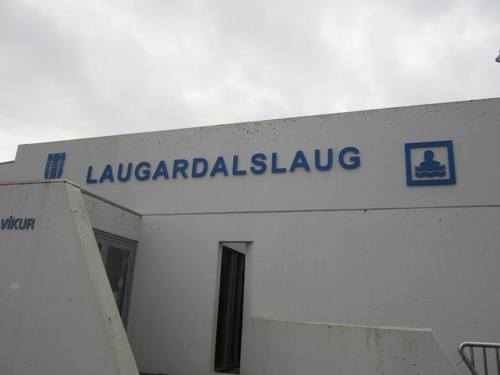
(1) The name of one of Reykjavík's public pool facilities.
Our next activity was part of the day's chance to cool down (warm up is probably more accurate) and spend some time with the program members. We went to Laugardalslaug, a public pool near downtown Reykjavík. Now, this place had some major twists. Apart from it being 40 F in May and being able to swim comfortably (the pools were heated), the pool's sanitation standards were pretty high. And by that, I'm really referring to the fact that everyone had to shower naked in their respective locker rooms prior to changing in and out of their swimming attire. And there wasn't really any way around this because pool attendants were around those showers, making sure you cleaned appropriately......
Other than that slightly awkward tidbit, it was nice that we (or at least most of us on the program) were mature enough to generally bypass typical locker room nonsense.
The pool complex from the outside

That colored tower was a waterslide, and for the first half hour of our time there we pretty much had trains of 8-15 people go down it at once (there were videos of this but I haven't had access to them). That didn't go longer than half an hour because a pool guard finally approached us and told us to stop.
Inflatable jousting

We proceeded to invade the next section of the pool, which had some really large inflatables that we jousted with for awhile. After getting bored of that, we all separated. I went to the jacuzzis with a few others; it was mildly warm, to the point that it was very enjoyable. I stayed there for the majority of the time playing some games with other members of the program. Towards the end I wanted to look around the pool a bit, and I found some really hot hot tubs. The hottest one I went to had a water temperature of about 105 F. I enjoy heat so it wasn't really an issue for me, but I will admit, I was sweating after 8 minutes and that was pretty uncomfortable (and so I left). For the first 30 seconds of being outside of the water I didn't feel the cold at all; I swore I steamed a little. But after that time I was freezing and returned to the other hot tub which was now swarming with GREEN activity. We soon left from here and went on to the next and final part of our day.
KEX Hostel
KEX was only a short ride away from the pool, and on that ride I got my first glimpse of what was considered to be downtown Reykjavík.
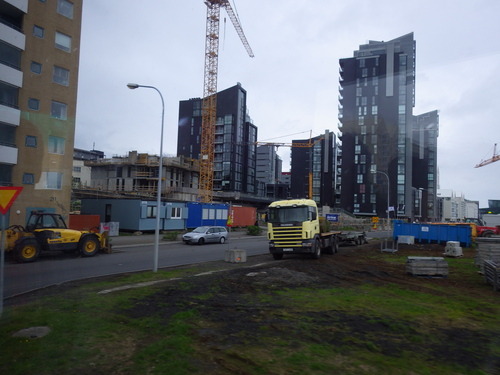

I'm pretty sure this is as tall as the buildings get in Reykjavík.

KEX is a popular hostel in Reykjavík. For those of you who don't know what a hostel is: it's like a hotel minus a couple amenities...like for example, shared rooms or dorms are more common than a private room, and bathrooms are also typically shared. It costs significantly more to get a private, single person room with a bathroom than to get a shared room and bathroom. Now, hostels are a lot cheaper than hotels (price-wise) which makes them very attractive to travelers. A couple of members on the program that got to Iceland before the program began stayed a night or two in KEX so they already knew the place, and a couple decided to stay there after the program was over. I stayed an extra day for my flight and stayed at the Reykjavík Backpackers' Hostel, which is pretty similar to KEX and almost as popular (more on this later).
Inside KEX. Pretty much the main lobby area (this was when we were leaving, after the bar closed).
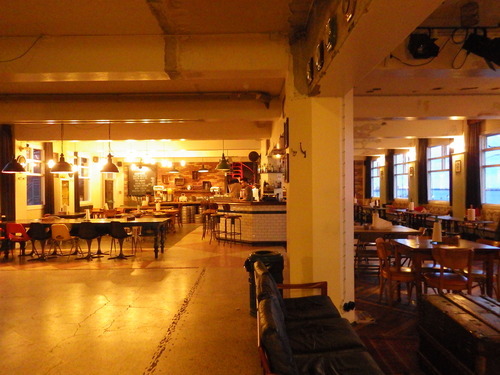
We left our mark even before the program began....
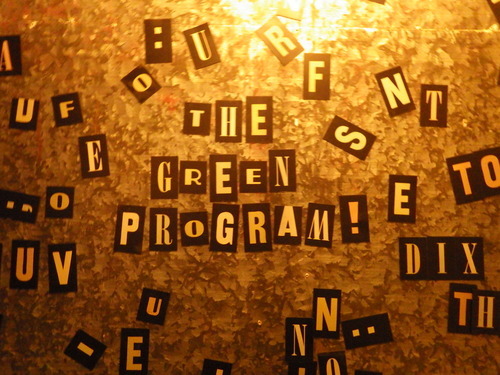
Now from there we went to an event room and had some dinner prior to the real madness. A quick note about the room: it felt as if time wasn't really moving until the leaders closed the shutters on the windows. Our time at KEX started at 20:00 (8 PM) and we left at midnight; the sky didn't look much different at midnight than it did when we came in.
My table.
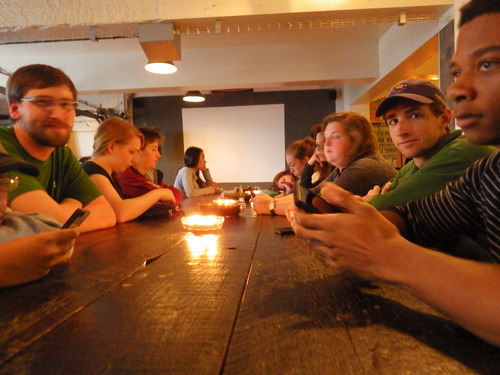
Dinner was quite scrumptious: fish (cod or haddock, no idea which) with potatoes and a particularly strange tasting salad that I ended up eating a lot of because no one else wanted any. Also, goat cheese.
And before I forget, lots and lots of beer. I didn't drink any, but the drinking age in Iceland is 20. It was at this point on the program that I realized that I was one of the younger members of the group because most of the students (I'd say 85ish%) had a mug with something hoppy in their hands. I was pretty impressed by all the different types of beers the place had, only because I'm pretty ignorant of the world of alcohol (as I should be).
Another table, probably the hoppiest of them all
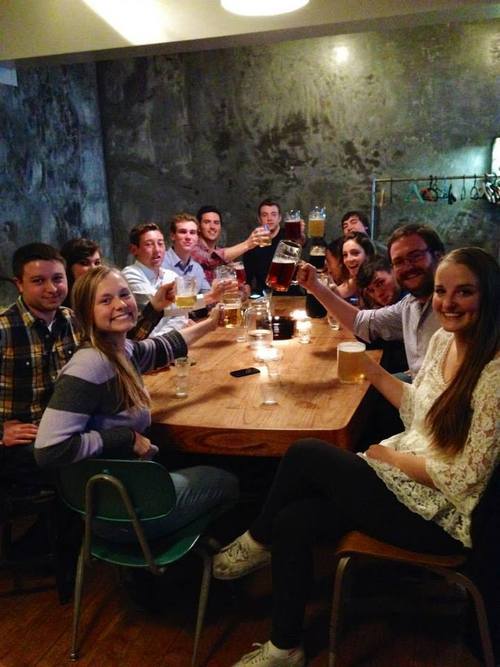
Dinner and the time after dinner was a really great time to get to know some of the students on the program. I could introduce you to everyone but for the sake of having to remember the stories of everyone I spoke with that day, I won't (maybe later! as a bonus).
After about an hour and a half of general camaraderie began the real reason why this post is titled as it is. We began a game similar to 20 questions, but after 5 or 6 questions would be a bonus round with a twist. The teams were our original designations from day 1 (Dragon, Unicorn, Puffin, or Mermaid). The questions were general trivia about Iceland and stuff that should be relatively fresh in our mind, like "What was Mumi's mother's name?" (We met a lot of Mumi's family when we visited South Iceland Adventure HQ on day 2) and "What is the population of Iceland?" (Hint: pretty small for an island that large). But the bonus rounds.....
The first bonus round: LIMBO

So, the leaders ask each team to send their strongest representative up to compete. I don't remember what team Suraj (pictured above) was on, but he absolutely demolished the competition and won it for his team. The reward for winning? Shots.
Now, before you say that the GREEN Program consciously gave its members alcohol, read this bit. I'm sure you'll get a good chuckle out of it because everyone else certainly did. So, Suraj's team wins the challenge and is totally excited to take the shots. They all let out a yell "Skál!!!" which is a traditional Norweigan toast kind of word, and take the shots. Immediately afterwards, we all notice their faces. Mumi asks after a couple of seconds if they could guess what they had just drank.... no answers. Mumi: "Fish oil." At this point, the room bursts into a pretty decent laugh and the "winners" are now further disgusted. Many of them would taste that fish for the next hours, if not, the next day.
Next bonus round: Arm wrestling.
Didn't have any pictures of this, nor do I remember who one, but I do remember their reward. It initially looked like a dessert, but after observing squashed-up faces upon consumption, it obviously was not something sweet. "Sheep's head".
The final bonus round: Musical chairs.
And then there were three.....

Steven (pictured above in the blue) won this challenge for us, and from that point on I prepped for the worst. Mumi brings out a package and some toothpicks and beckons that each Dragon take one. When I saw it, it looked a bit like a dessert I had seen from the Dominican Republic. Not even close. At first taste I immediately knew it was something from the sea because it tasted very fishy and was pretty salty, but it altogether wasn't terrible. I felt pretty lucky that that was our twist. Post-consumption: "Dried shark".
We had a good laugh. The bar closed shortly after this so people got their last drinks, and we left at around midnight and headed back to Hjarðarból. I stayed up for the bus ride, admiring the landscape at a time without sun but not quite night. After I got in the room back at Hjarðarból, put on some pajamas, and brushed my teeth, I dropped like a stone.
#GREENprogCH1#summer#fun#reykjavik#iceland#scandinavia#hostels#europe#great times#strange foods#KEX#pools#supahotfire
1 note
·
View note
Text
Only Hours Betwixt Twists (Part 2) (Plant 2/2)
Hellisheiðarvirkjun
This is from Wikipedia. Those pipes ferry saturated steam from the geothermal well zone to the plant.
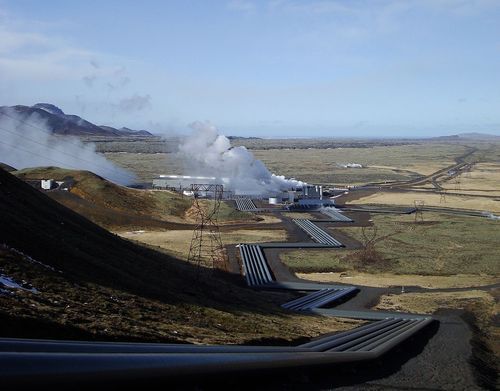

From afar (not taken on Day 3). Most of that steam is coming off of the plant's cooling towers.
Built in the very geothermally active Hengill area, Hellisheiðarvirkjun is Iceland's largest geothermal power plant and the world's second largest. The plant produces 303 MW of power sourced from high-pressure steam originating from 30 wells drilled about 2-3km deep in the Hengill reservoir. The plant also supplies large amounts of hot water (about 400 MW worth) for immediate use in heating and other typically energy-intensive uses.
(numbers from Extreme Iceland)
Presentation.
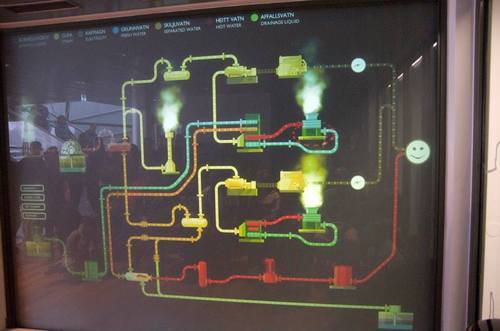
Before entering the facility, we were given a short presentation on how the entire system works.
If I remember correctly, the geothermal zone has porous rocks that water seeps into and is subsequently heated up such that it vaporizes. This vaporized water (steam and some water clinging to it, termed saturated steam) is brought up to the wells from very deep in the earth by convection currents and is then channeled through the well system and into those pipes that were pictured earlier. Those pipes lead to a mist separator system that removes the water from the steam. From there, dry steam is sent to the turbines where it pushes through the high pressure turbines at a pressure of about 9 atmospheres (9 bar or 8.88 atm to be exact) and the low pressure turbine at about 2 atmospheres. Steam pushing through to turbine drives the turbine blades which are connected to a generator to create power. That power is modified in a variety of ways to make it compatible with the country's power transmission system. The steam is then pumped back into the ground to repeat the cycle. The water separated from the steam either gets recycled back into the ground or goes to the hot water processing plant for piping to cities and industries.
Turbines
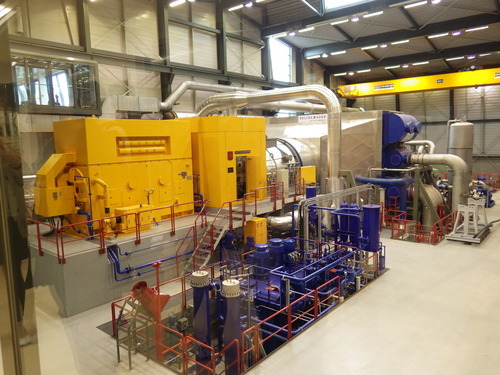
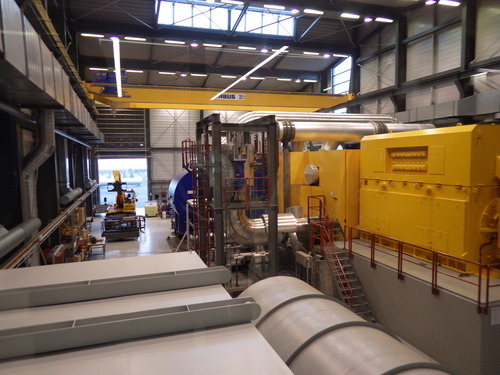
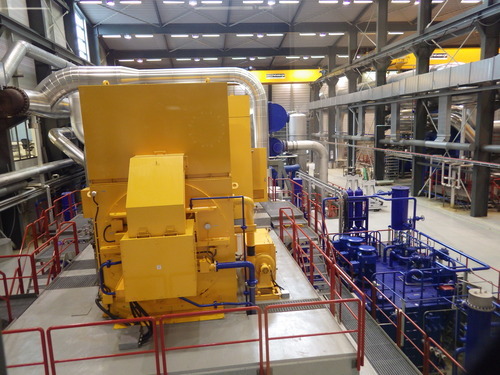
The power generation component of the plant consists of 6 high-pressure steam turbines, each capable of generating 45 MW of electricity, and 1 low-pressure steam turbine, capable of producing 33 MW of power. Fun fact: the high pressure turbines are made by Mitsubishi.
Hot water processing.

This is the hot water processing part of the plant. I don't exactly remember what happens here.
Turbine repair.
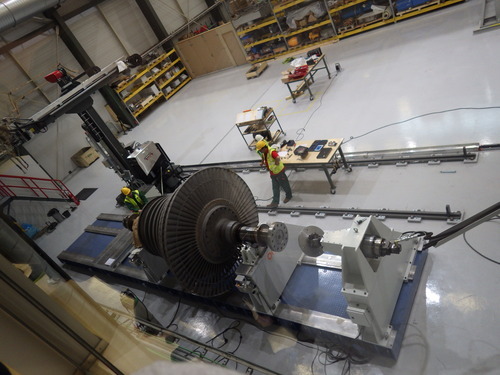
Once we exited the bowels of the facility, we got to explore the plant's visitor center. The upper level had some really awesome info-graphics, models, and views of the plant.
Modeling.
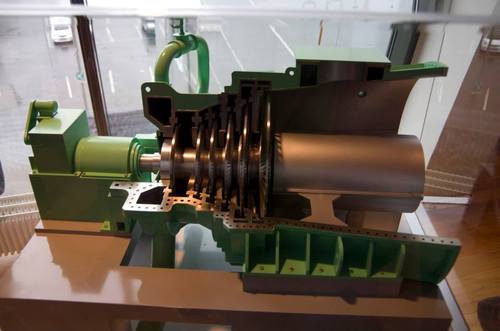
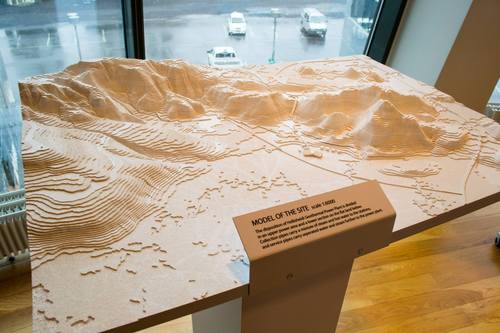
(1) A model of the inner workings of a high pressure turbine. (2) A topographical model of the geothermal plant site and some of the surrounding Hengill area.
Infographics.
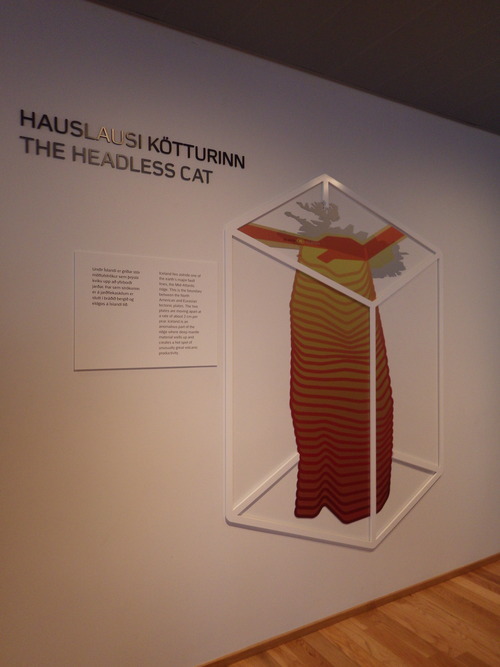


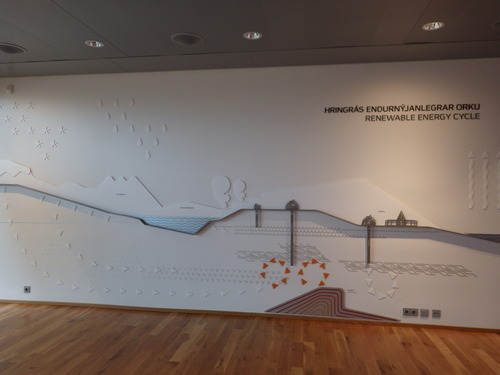
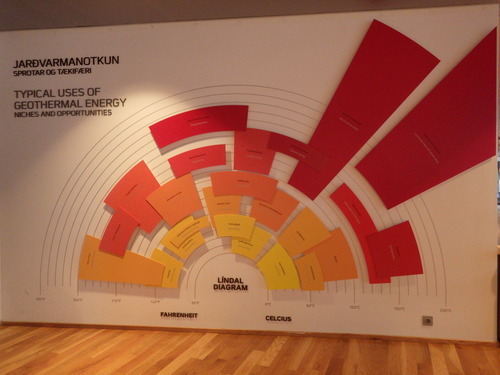
(1+2) The "headless cat" analogy is meant to be representative of the structure of the hotspot that Iceland sits on top of. The surface-level orange zones designate the tectonic plate boundary (North American and Eurasian plates) that runs through the island (something you'll be able to see physically VERY soon). (3) A diagram explaining how the hot water produced here is sent to nearby population centers. (4) A diagram showing an Iceland-specific atmospheric and geological water cycle for the geothermal zone. It helps to explain how geothermal is actually renewable. (5) A large Lindal diagram showing what temperatures are required for thermal processes such as heating a home or a swimming pool, providing energy for a smelter, dehydrating food, etc.
(Unfortunately I did not get a picture of the famous "energy consumption around the world represented by Big Macs" diagram)
The upper level of the visitor's center also had a terminal that simulated the various earthquakes that have occurred at the plant since its construction, a place to sit down and watch an informational video about how geothermal energy works and Icelandic history. And these observation decks.
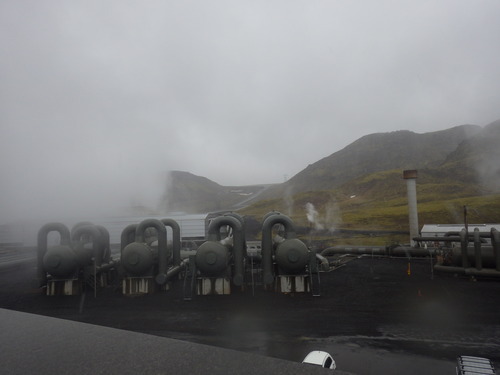


In the main exhibition hall was the main desk, a gift shop, a small eatery, and various collections.
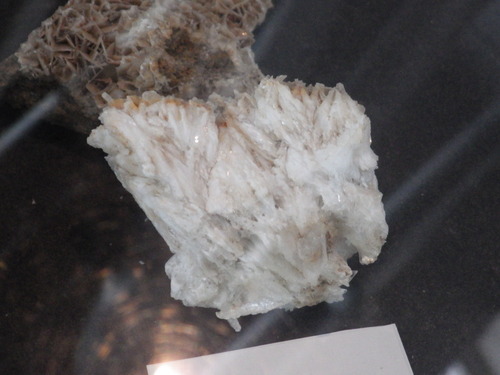
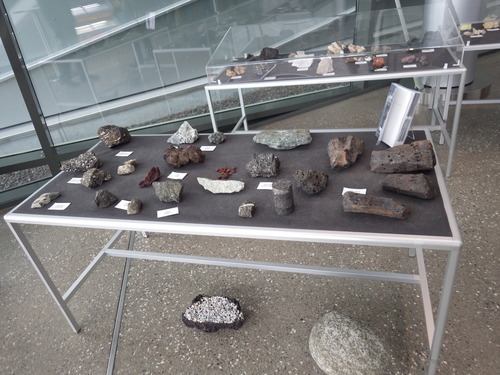

(1) A mineral out of the rock collection they had. (2) Part of the collection itself. (3) An example of a drill bit used for well exploration.
And of course we took group photos.
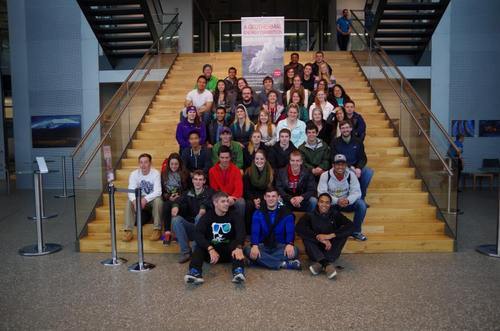
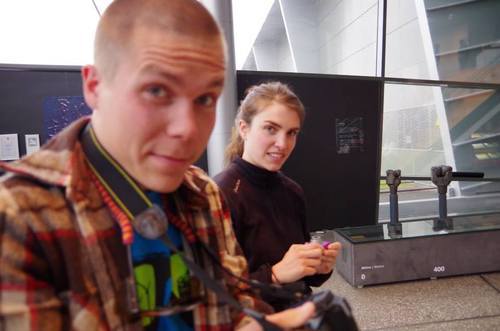
The two at the bottom were our guides, Mumi (not his actual name: he spared us having to pronounce that) and Helga. More on them later.
Outside. The smell of sulfur was strong with this one.
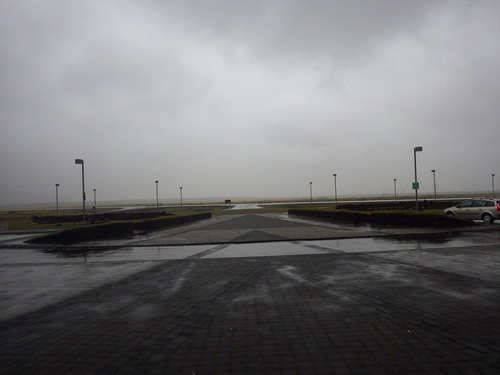
And now, the day's real twists begin.
#GREENprogCH1#Hengill#hellisheiðarvirkjun#geothermal energy#engineering#science#onlyonthegreenprogram#thegreenprogram#iceland#travel#study abroad
1 note
·
View note
Text
Only Hours Betwixt Twists (Part 2) (Plant 1/2)
So after the lecture we visited two power plants, Elliðaárvirkjun and Hellisheiðarvirkjun.
Elliðaárvirkjun (main generator housing)
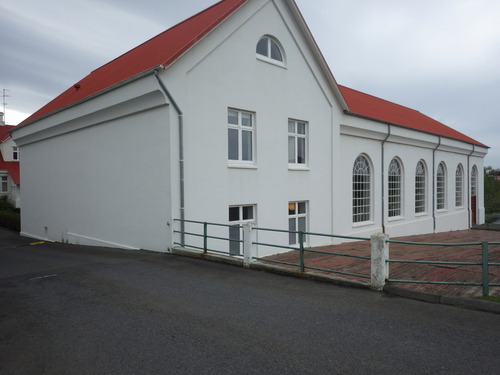

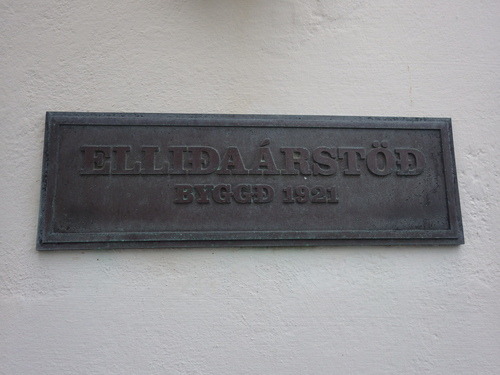
Elliðaárvirkjun is a hydropower plant that was built in 1921. It was the first power generation facility built in Reykjavík, and it still operates and produces power to this day. Personally, I thought this place was really awesome because it simultaneously serves as a historical site and an active part of the city's power infrastructure.
Inside Elliðaárvirkjun
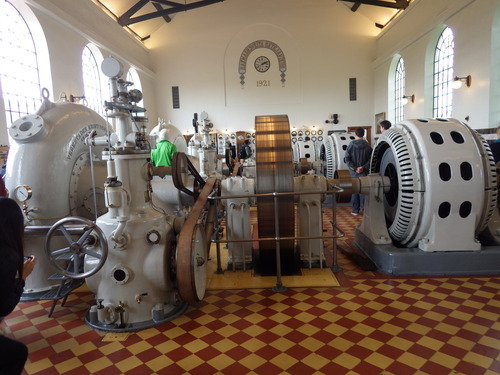
I found it fascinating how we were able to build complicated structures like these even as far back as the 1920's.... it really serves as a testament as to what we are capable nowadays in the days of Internet, drones, crowdfunding, etc....
Dylan here is a bit taller than 6 feet (so now you have a better idea of how large these generators really are).
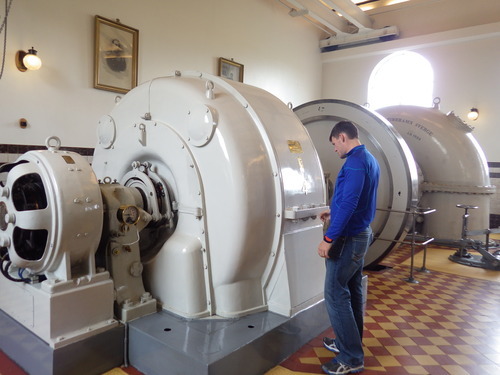
Inner workings.

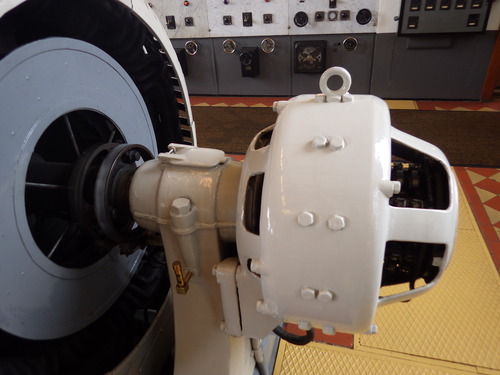


One question I regret not asking: What was this and what did it do.
Readings, display-side and behind-the-scenes.

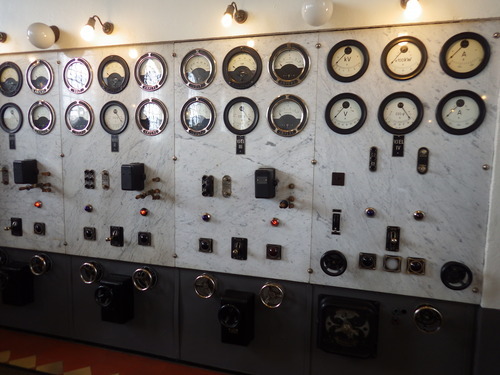
Generator auxiliary controls.

The plant kept portraits of all the station managers and managed to save even the original tools used on the machines. They even had a house for the managers to stay in.
Portraits.
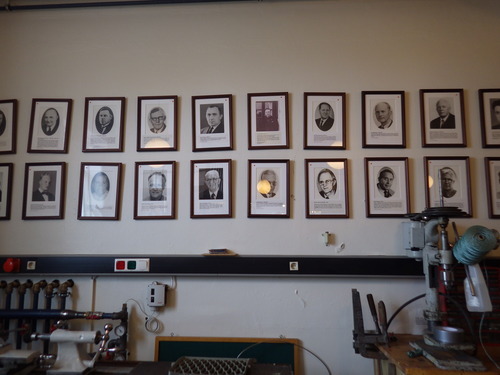
The original management back in 1921.

Viking-sized tools for.... well... Vikings.
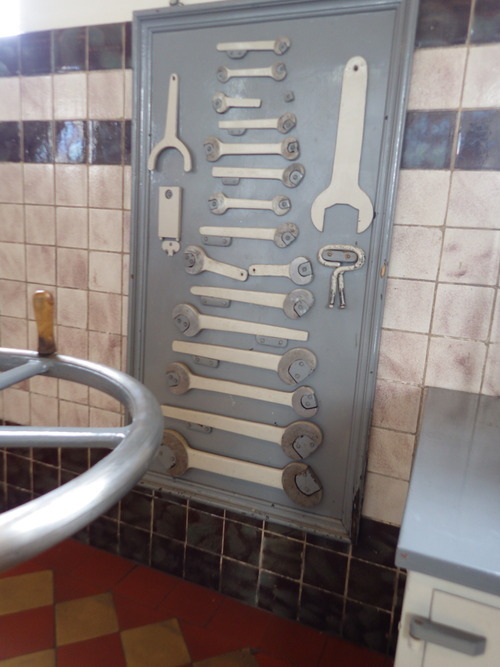
The station managers' house.
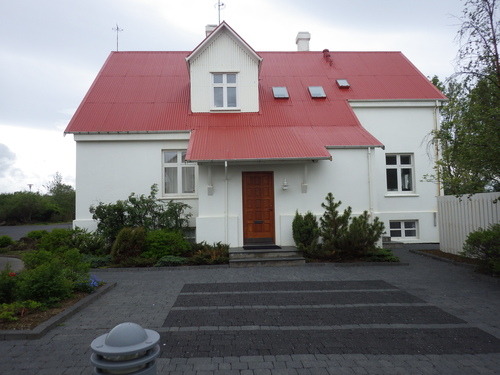
For a facility that is almost a century old and still producing 3.2 MW of power, I found it all rather impressive. Now I hadn't previously mentioned this but the facility was in repair at the time we visited. I don't remember the exact cause of the shutdown, but I do vaguely remember the tour guide mentioning that something very large smashed into something else very large and things broke.
Outside.

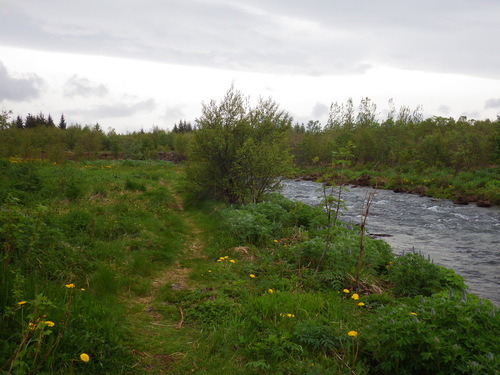
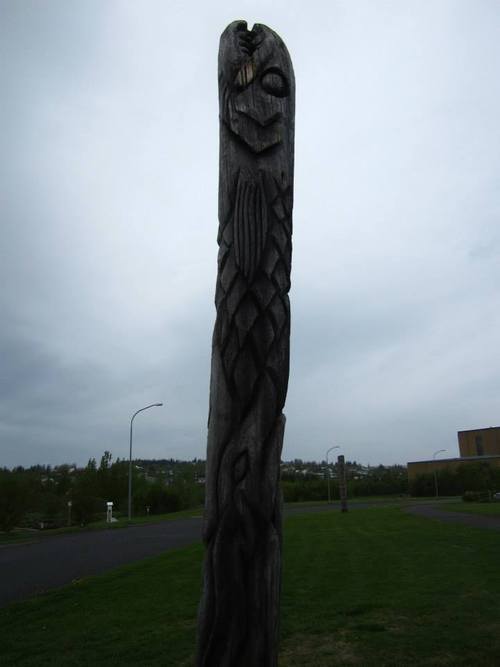
Another question I regret not asking: what were the origins of these totems.
#GREENprogCH1#reykjavik#Elliðaárvirkjun#hydropower#green energy#history#onlyonthegreenprogram#thegreenprogram#iceland#last minute blog work#finally doing it#study abroad#travel#scandinavia#day 3
2 notes
·
View notes
Text
Only Hours Betwixt Twists (Part 1, Lecture 2/3)
The second lecture was about basic energy economics.
Prior to this I had absolute-zero background on economics, so I thought it was pretty cool to have a first exposure to it in the context of energy. I recognized a lot of the terminology in the lecture only because of some educational modules everyone on the program was required to complete prior to the beginning of the program.
This would be a boring lecture to write down if you weren't all that interested in it (which I am not, so I won't). However, a fairly good amount of the information provided proved useful in the development of our capstone projects.
We had lunch (Icelandic Domino's!) after this lecture.
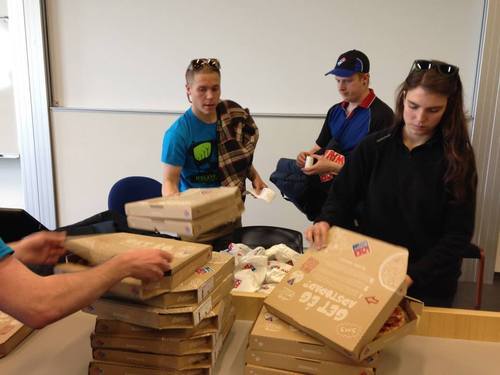
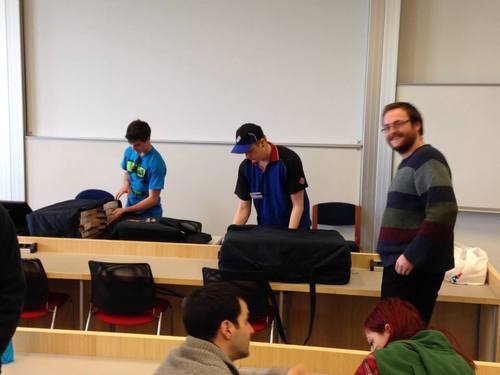
We had leftovers that disappeared at the end of the day; they were later found in the bus storage compartment a week later for some reason.....
The third and final lecture was all about hydroelectric power.
A loooooot of what was covered was mentioned in the lecture was previously taught to us by the modules, so no one really paid attention here. I wrote down some things that weren't mentioned by the modules.
By the time we left it was around 13:00 or 14:00; everyone was glad to leave. And so we proceed to our next twist.
Note: there will be a side project following the completion of the blog's main content that will go over almost everything covered in lectures in detail (that encyclopedia content I didn't think people would be too interested in).
#GREENprogCH1#thegreenprogram#iceland#reykjavik university#there will be more later#if I get to it#(hopefully I will)
0 notes
Text
Only Hours Betwixt Twists (Part 1, Lecture 1)
Twist 1 (not really a twist because we were warned): we woke early in the morning (06:00ish) to attend several lectures (three to be exact) at Reykjavik University.

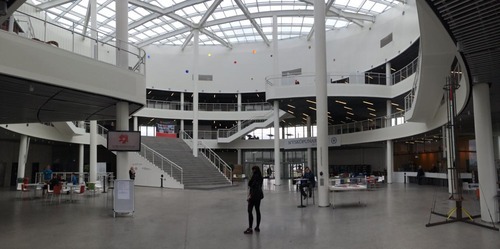
(1) The front and (2) main lobby of Reykjavik University
The first lecture of the day concerned Iceland's climatological/geological, anthropological, and energy history.
1) Iceland's current climate and geology is the product of a perfect storm of attributes and events that occurred in Earth's early history. Iceland sits on top of a hotspot and a tectonic plate boundary, which is why it is so geologically active (riddled with volcanoes).

A map of the country's volcanoes.
The volcanoes are what formed the island almost 60 million years ago, but the reason why it isn't entirely flat is because of the glaciers that passed through the area during the Ice Ages and the rifts valleys that form as a result of the separation of the North American and Eurasian tectonic plates. The glaciers played a far larger role in changing the island's topography than the rifts did.
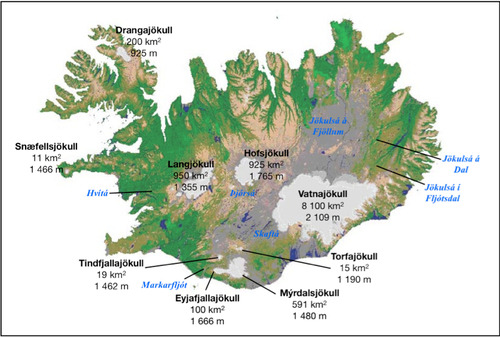
Iceland glacier map.
Ocean currents and air currents that pass over and flow around the island are responsible for bringing heat and moisture to the area, and the mixing of warm and cold currents bring nutrients vital to marine life.
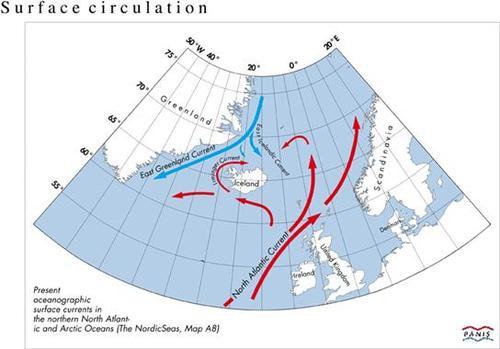
Ocean currents around the island.
Volcanic eruptions also had profound effects on the climate.
2) Iceland's first peoples brought livestock (mostly sheep) with them and were responsible for the large-scale deforestation of the island, which made the land susceptible to erosion, leading to some pretty epic Dust Bowl-like events (ash from eruptions also played a large role in providing loose sediments to be blown around by Iceland's crazy wind).
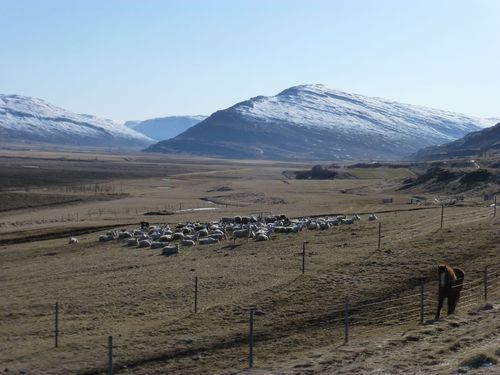

(1) This is what the majority of Iceland's farmlands look like. Barren, (2) which leads to massive soil erosion, like this in the desert highlands.
Major eruptions often lead to widespread famine and nearly wiped out the island's population on multiple accounts. The first peoples also preferred isolation from the rest of the world, a trend that is decaying slowly in today's global interactions. Until the industrialization of Iceland in the 1970s, the people's livelihood depended greatly on fishing and farming.
3) Up until the 20th century, Iceland's inhabitants used peat, wood, and dung as energy sources. At the beginning of the 20th century (1904), Iceland's first hydroelectric power generation unit was built, supplying 9kW to the town of Hafnarfjörður.

Plot showing change in energy resource use between 1940 and 2006 (sorry that the plot is so small).
In 1908, the first geothermal home heating system was constructed in the countryside near Reykjavik. The first large-scale (in excess of 100MW of capacity) hydroelectric and geothermal power plants were constructed in the 1960s, which (on a side note) drove the national electrification of the country and paved the way for large industries (mostly aluminum smelting) to move in.
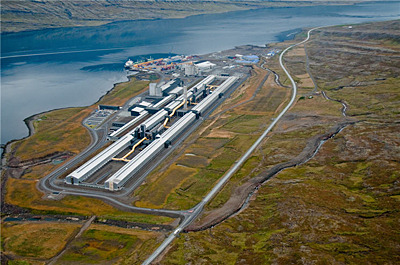
Alcoa smelting plant in Reydarfjordur.
Since then, the country has drastically developed its geothermal and hydroelectric power schemes and has pretty much entirely phased out fossil fuels from its energy sources (with the exception of a few very remote villages).
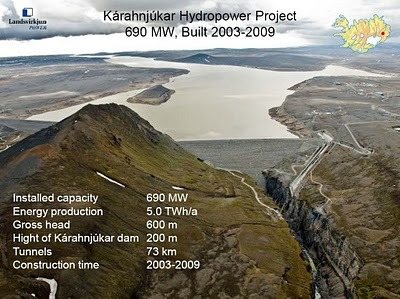
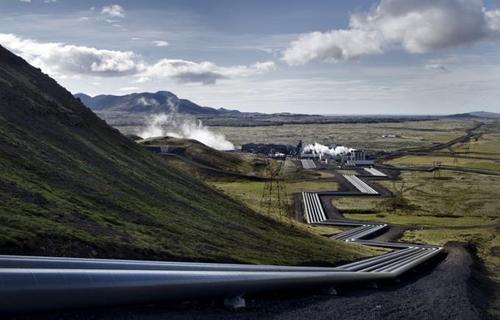
(1) Kárahnjúkar, Iceland's largest hydropower plant and (2) Hellisheiði, the world's second largest geothermal plant (we'll see more of this later!)
*end lecture 1* (note: all lecture-related pictures from Internet)
#GREENprogCH1#reykjavik university#history#iceland#day 3#volcanoes & stuff#thegreenprogram#dat summer education#energy
0 notes
Photo

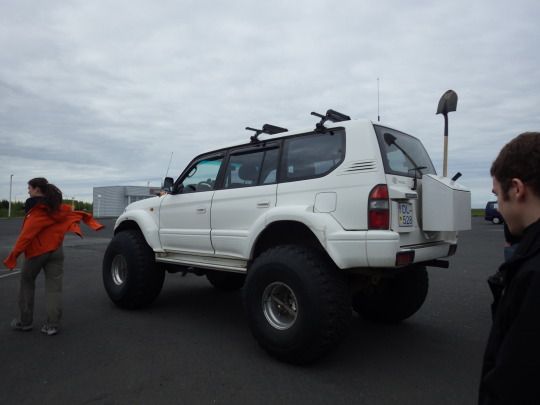
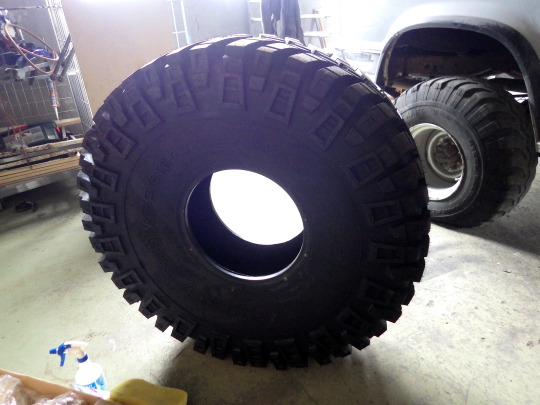
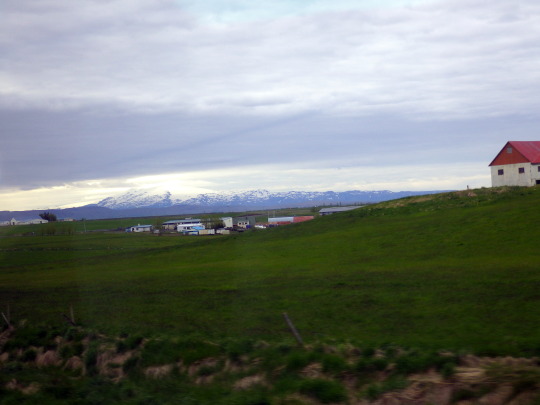
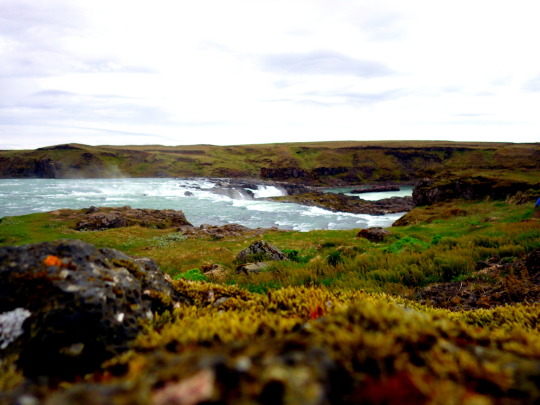
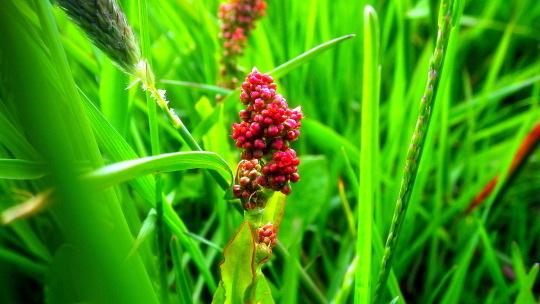


More moments from day 2.
#GREENprogCH1#thegreenprogram#iceland#reykjadalur#clouds#waterfalls#plants#valleys#gettin artsy with it#super late#whatever#travel#the great outdoors#day 2
1 note
·
View note
Audio
This song was literally perfect for everything about Iceland.
Whether it was driving through the countryside or scaling the mountains, it was something I constantly had running in my head. 10/10 would use for something cinematic in Iceland.
1 note
·
View note
Text
Of Rotten Eggs and Reykjadalur (Part 3)
After the hike we returned to the guesthouse. We had some time to do whatever we wanted and then we had some activities regarding the capstone project.
We started off with a personality test that identified each person with one of four colors, each color representing a set of personality traits. Yes, the exercise was meant to promote variety in personality in each group, but since two colors resonated throughout the majority of the students, every group had their personality banks. if you will, skewed towards one of these trait groups. Nevertheless, the color system wasn't really mentioned again past that day with the exception of some jokes.
After groups formed, each one was to come up with their own project topic that would be pitched to the program leaders later in the week. The project was supposed to be a business proposal for a renewable energy or environmentally sustainable idea. I personally had no idea what group I was going to work with or what project I was going to work on, but after some searching I found a group that was thinking of doing a project somewhere along the lines of sustainable development. After meeting everyone over some fried haddock and potatoes and other assorted dinner goodies, we decided to focus our project around green roofing. After getting our schedule for the following day and brainstorming some project specifics, we split and went our separate ways.
I went to call my parents and write up some blog stuff. That was the only night where I really got to do either of those.
1 note
·
View note
Text
Of Rotten Eggs and Reykjadalur (Part 2)
So, the Reykjadalur valley is a geothermal complex sprawling with hiking routes in south-central Iceland, slightly northeast of Hveragerði.

A small slice of the valley (Dragons in the lead, here).
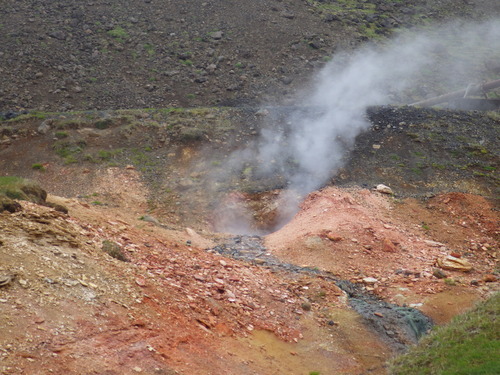
Just seeing steam rise from the ground excited me because I had never seen geothermal activity in person. On this second day of the trip, the program's Instagram competition officially began, and so me being a tryhard jumped in the nearby river, trying to get a half-in, half-out shot of the valley from the river (my camera is waterproof). But dumb me forgot you need still water for a picture like this to come out nicely, so I left with this shot of most of the program members disembarking from our bus:

and a great understanding of how hiking boots cannot be waterproof if they have a ventilating mesh (my socks were soaked for the remainder of the day, which only sucked a little bit).
The first bit of the hike wasn't too steep, and we stopped for a short break near the top of the first vertical section.

We started near that red blob in the center of the photo.
A little further up and we came upon the beginning of the ridge zone. Slight spoiler: it was cloudy for the first 8ish days of the trip; however, I thought it was pretty neat to see the clouds hiding the mountain peaks (not that these mountains were actually tall) only because it meant the ability to touch the clouds was only a hike away.
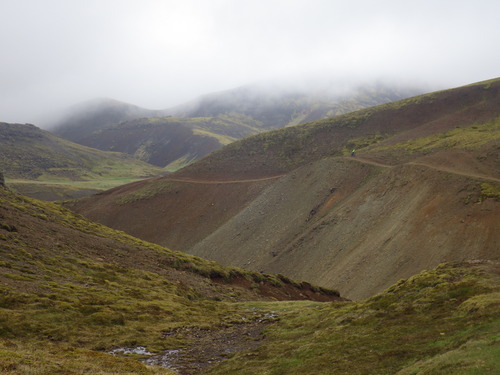
Cloudline spotted!
There were only a couple ridges to cross over, and in between each one was a new sight to behold.

Between ridges one and two.
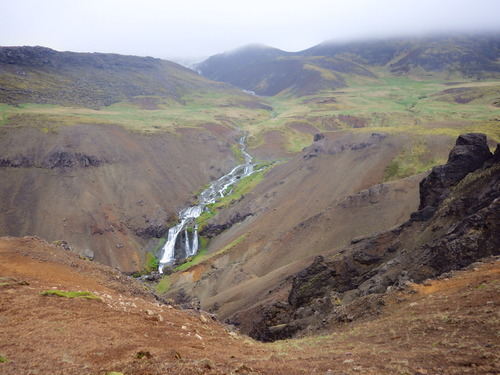
Between ridges two and three. We didn't get to see this waterfall up close, but believe me: we had plenty of other waterfalls to see on this trip.
After getting over the ridge zone, the valley really started to pan out:
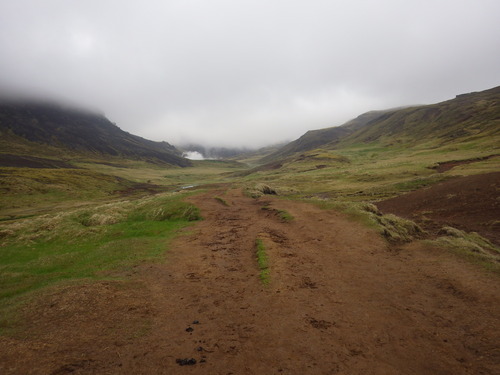
After passing through some pretty deep mud at a stream crossing, we began to enter the really geothermally-active part of the valley. Large plumes of steam rolled through some portions of it in waves. Walking through it further added to the hype of being in Iceland and it was in the cloud where I had my second "pinch-me-I'm-dreaming" moment. I'll never forget closing my eyes and feeling like I was surrounded by hard-boiled eggs ("rotten" in the title was a bit of an overstatement)
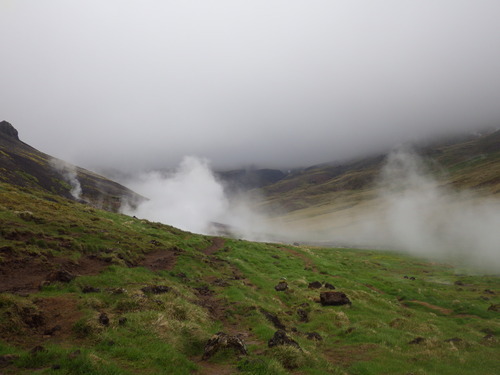
A little past the steam cloud was our destination. A junction where a set of streams meet. These streams carried freshwater from the mountain springs that mixed with hot water from the geothermal valley floor which created these natural hot rivers that people can stay in for a while and enjoy as if they were a hot tub (just a thousand times better because of the ambiance). I would've taken all sorts of pictures here but my camera can't handle the temperature change between the hot water and the cold air (it was about 45ish Fahrenheit that day).
So, at this point we all changed into bathing suits and swimming trunks and whatnot and got it. Again, more unreal moments. After a bit of relaxing, a bunch of us decided to go deeper into the valley. I really enjoying trudging through cold mud barefoot; it was a sensation I had never felt before. Oh, and I didn't say: the only reason I was walking in the muddy grass parts in the first place was because the majority of the river further up was far too hot to be in. By the time I stopped advancing, there were two others (we started with around 10): our furthest point was a new ridge where what seemed like a crater (or at least a VERY large fumarole) lay ahead. We sat on the side of the ridge, just taking it all in. "Pinch-me-I'm-dreaming" moment #3.
The crater in front of us, billowing steam. The black rock walls rising all around it. The cold grass under my feet. Black slugs as fat as your thumbs all over the rocks next to us. A path to go further on our left. The steaming river running through all around us.
tl;dr: a moment we won't ever forget.
I was almost sad to leave that spot, but I did. After submerging myself in the hot stream a couple times, the time to leave finally came. I had no desire to do so, but we did.
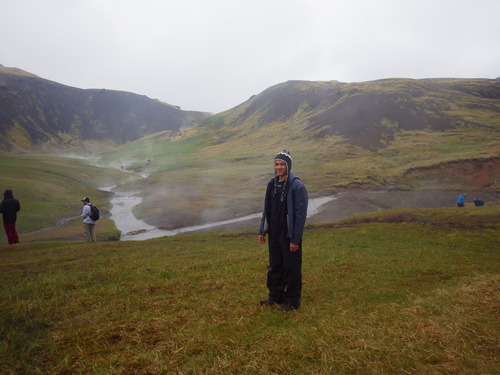
Still-freezing boots and socks: check. Snow pants (because I couldn't get waterproof pants in time): check. Icelandic hat and too many layers: check.
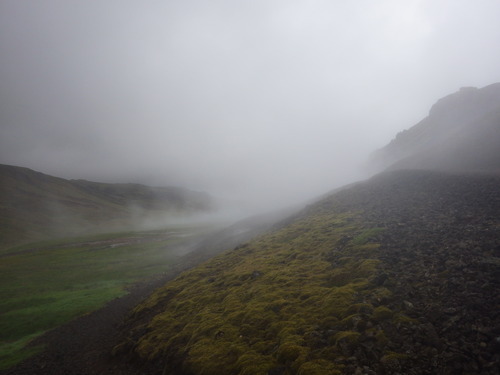
This steam cloud was basically a portal between the ridge zone and the hot rivers junction.
I really wasn't aware that we were going to have hikes like this on the trip, but boy was I glad we did. The return to base seemed to go by much quicker than our ascent to this spot. The only hitch on the return was a spot where many people stepped in some very deep mud (attributed to a nearby stream). I avoided it by hopping on some rocks.
It only took one hike in Iceland to know that the next 9 days couldn't accurately be recreated in pictures or videos.
1 note
·
View note